How Small and Mid-Sized Businesses Use Social Media in 2025: Survey Results
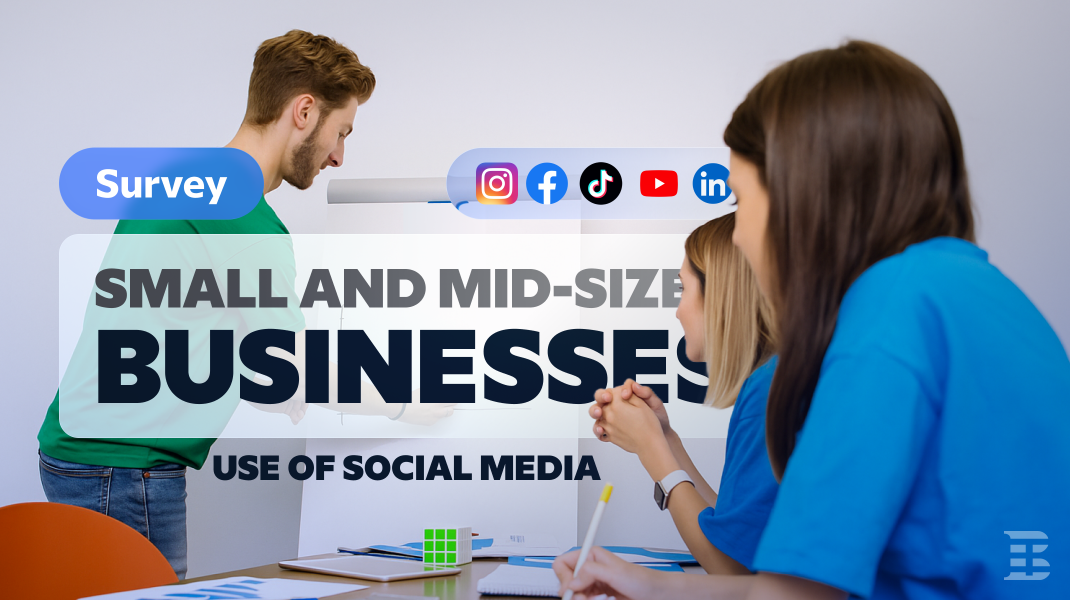
Summary
TechBehemoths surveyed 1,960 IT companies from 53 countries between September 3–21, 2025, to understand how businesses use social media. The findings highlight the platforms companies rely on, how they allocate resources, what content works best, and the challenges they face. The data shows that social media is essential for visibility, lead generation, and engagement, with trends like AI and personalization shaping future strategies.
Key Insights:
- LinkedIn leads the way – 99.5% of companies rely on it.
- Most manage social media with just 2–3 people.
- AI is here – 60% use it occasionally, while 14% rely on it heavily
- Ongoing struggles – time (50%) and budgets (40%) are the biggest barriers.
- What’s next – more focus on blogs, short videos, and AI-driven content.
If you are not on social media, it’s like your business doesn’t exist. These days, an online presence is a must-have — at least on one platform.
Choosing the right channel and strategy can feel challenging, but once you define your direction and stay consistent, social media can truly help your business grow.
To better understand how things work — which social platforms companies rely on, the challenges they face, and the trends shaping the future, we surveyed 1,960 IT companies across 53 countries between September 3 and September 21, 2025.
Here’s what we found. The insights gathered provide a clear view of how businesses approach social media today.
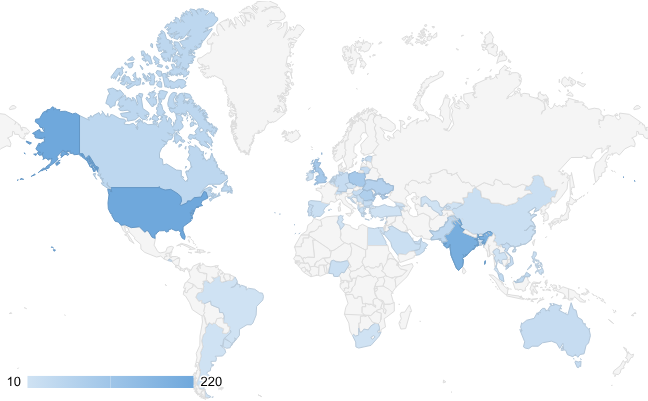
Survey Respondents’ Profile
Who Took Part in the Survey? With stronger participation, there are regions with high digital adoption and active small to medium-sized businesses (e.g, the United States, India, the United Kingdom, and Poland). Regions with smaller business sectors, limited reach, or different priorities (e.g., Tunisia, Thailand, Oman) had a lower participation.
In addition to diverse demographics, respondents also hold diverse roles within their companies. Over half of the respondents are CEOs and founders (51%), indicating their strong involvement in social media strategies within their companies. Following them are marketing specialists (34%), who have a central role in putting strategies into action.
Other roles, like business development (9%), technical, and HR (6%), are less represented, reflecting their more supportive involvement.
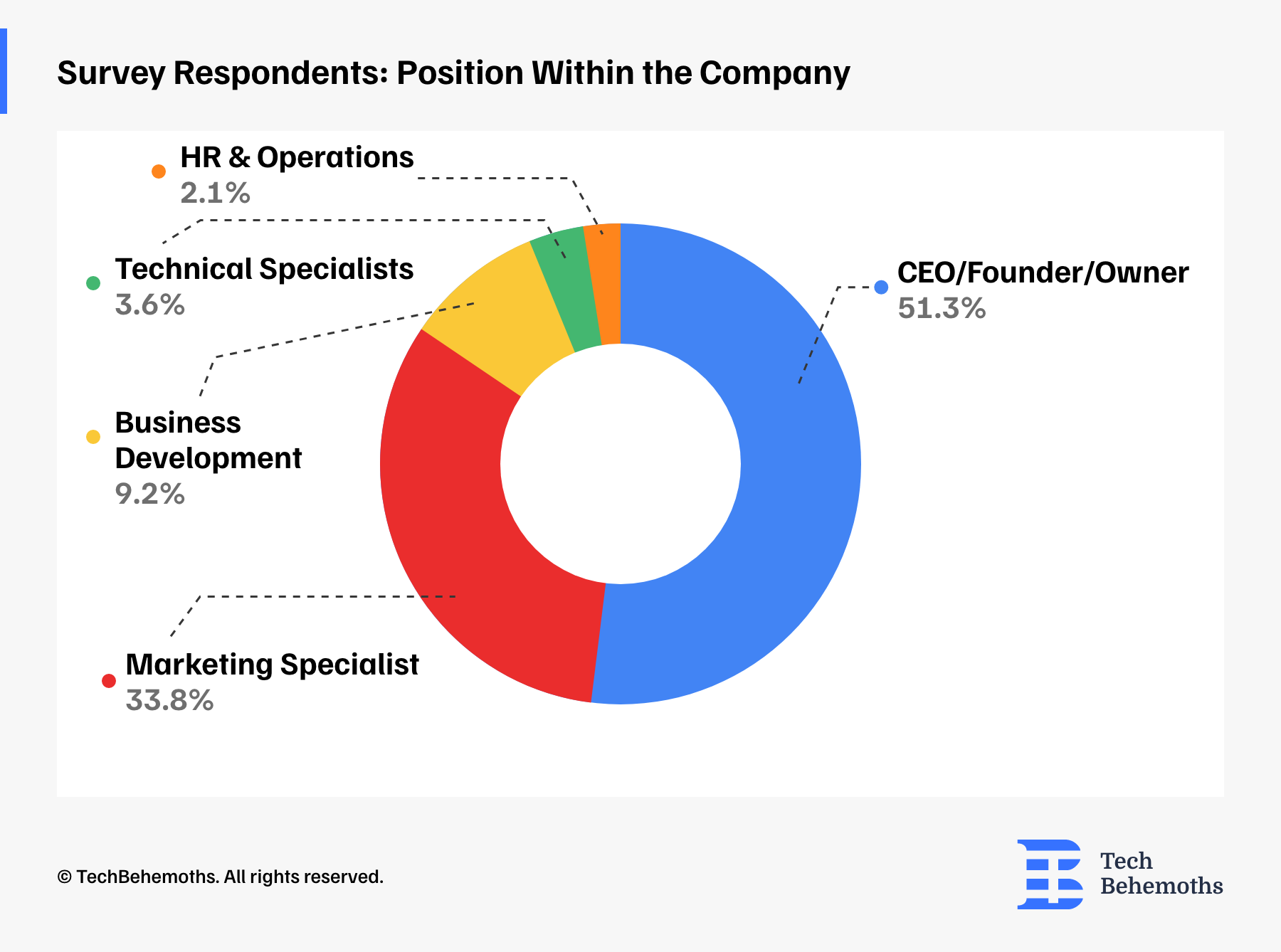
Company Size Distribution
Regarding the size of the respondents' companies, most respondents come from small businesses (under 50 employees), making up 72.9% of the total. This suggests that many small teams see social media as a cost-effective way to grow. Medium-sized companies (above 50 employees) also show strong involvement (27%), reflecting the integration of social media as part of their structured marketing efforts.
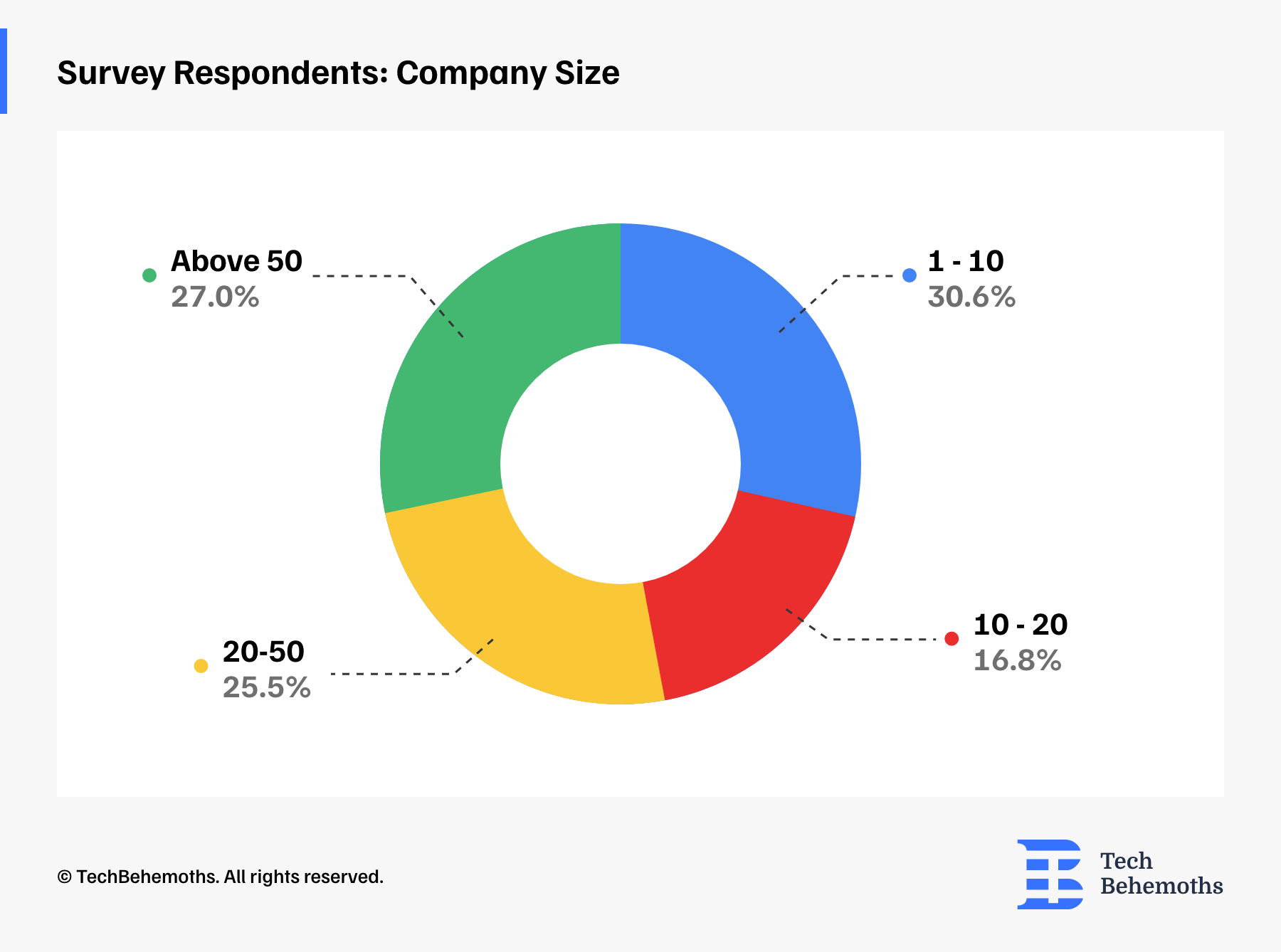
Industry Distribution
Nearly 7 in 10 respondents (68%) come from software and application development, showing how much digital-first industries rely on social media for visibility and getting clients. Companies in digital marketing and design (12%), IT services (9%), and consulting (7%) also have a notable presence, reflecting social media’s importance for brand positioning. Smaller shares from media production (3%) and niche industries (1.6%) highlight more specialized uses of digital channels.
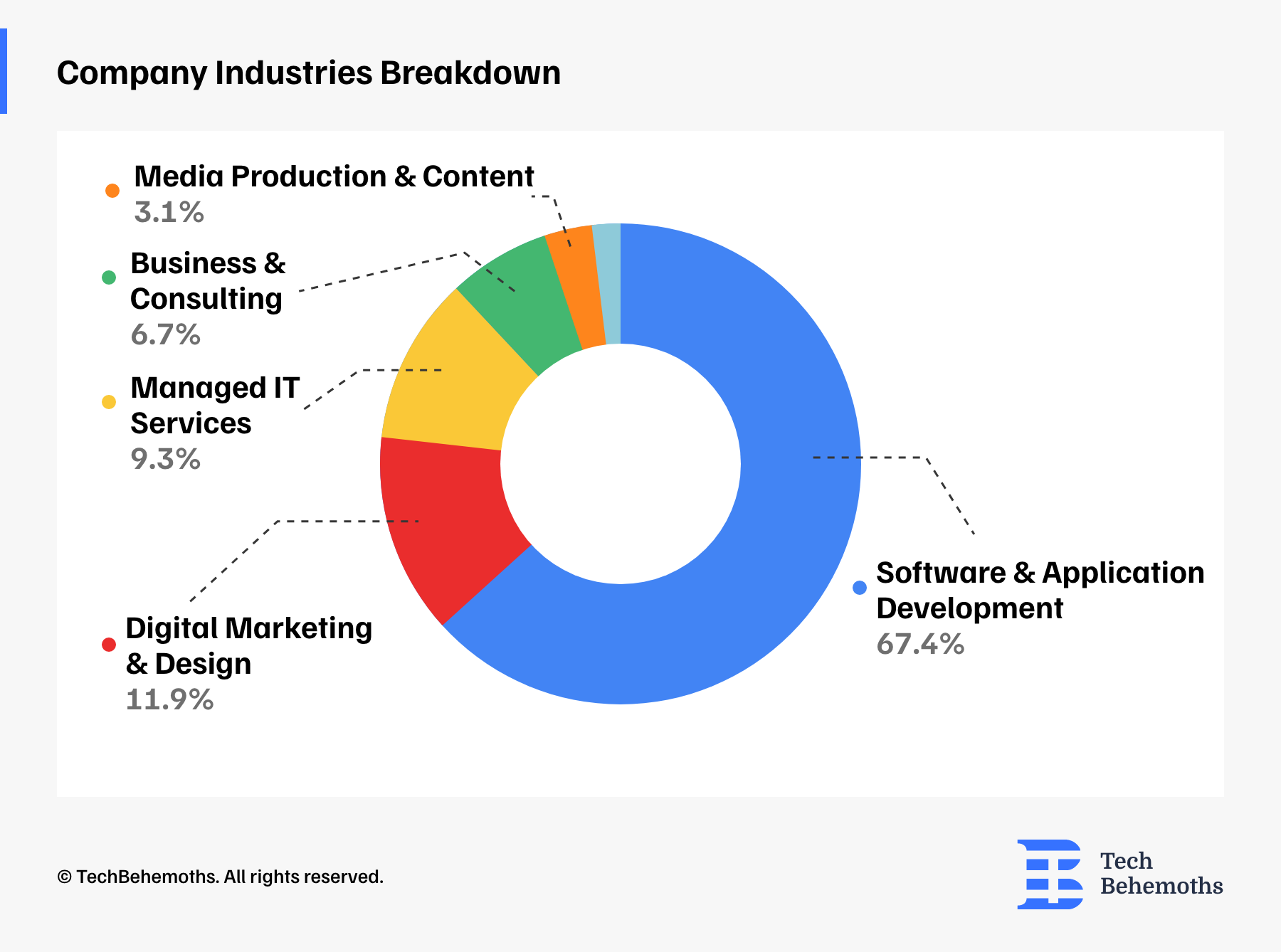
From Baby Boomers to Gen Z: Who Runs Social Media Strategy?
According to the TechBehemoths survey, the Millennial generation is in the lead (almost 70%), which corresponds to their position in managerial and leadership positions, where strategic marketing decisions are made. They are the generation that grew up with the internet, so they are skilled in using digital tools and have business experience.
Generation Z (36%) is the rising creative force behind social media content. They excel at short videos, trends, and digital communities, meaning they shape execution and innovation, even if they don't yet define strategy at scale.
Millennials set the strategy, Gen Z drives the trends.
Gen X (17%) and Boomers (3%) are present but play a smaller role. This reflects a generational gap: while they may oversee budgets and long-term direction, they are less involved in daily digital tasks.
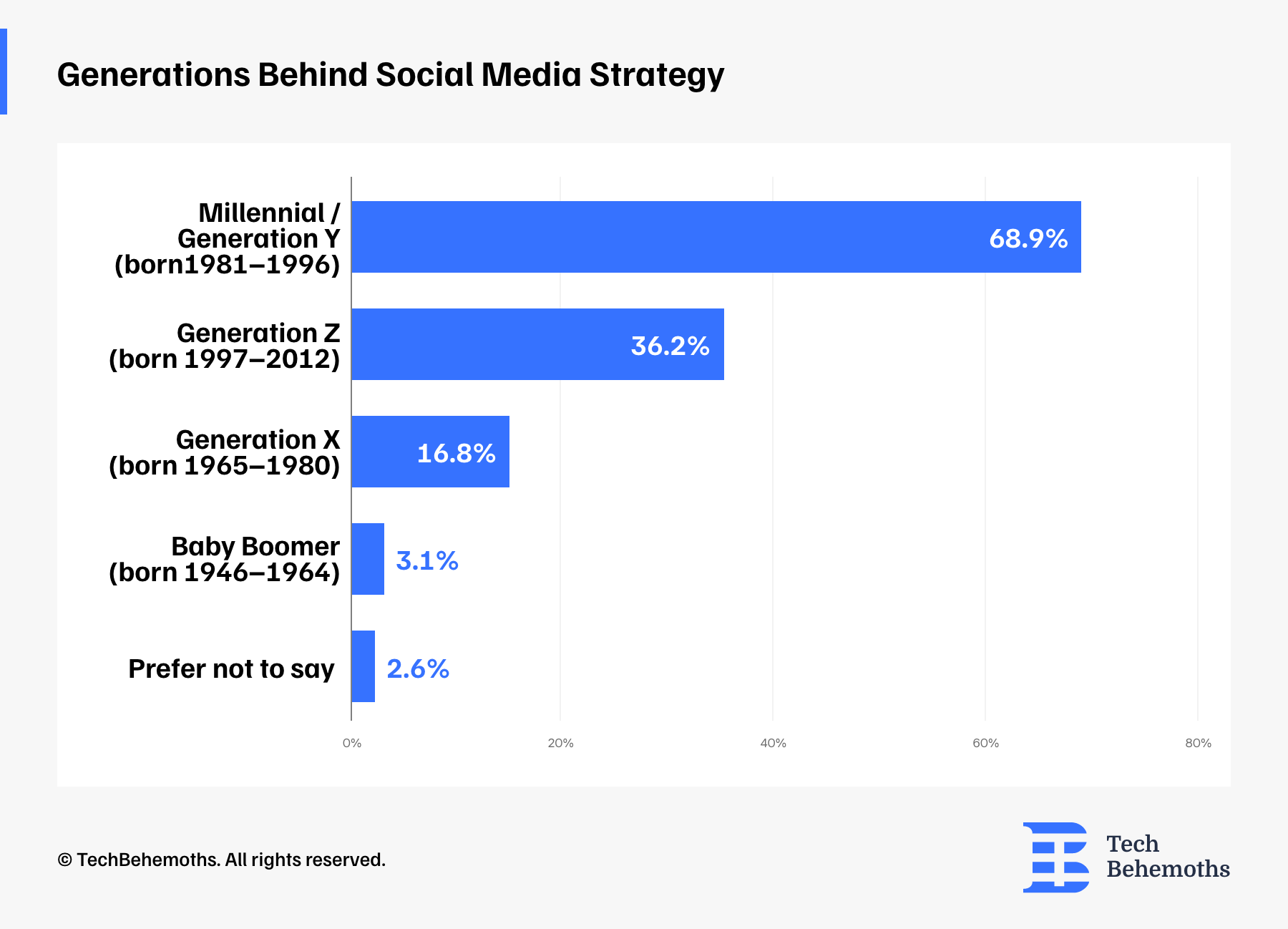
99.5% of Companies Use LinkedIn
The leading social media platform for small and mid-sized businesses
When asked which social media platforms companies use, the majority (99.5%) mentioned LinkedIn. Such a dominant choice is explained by the fact that small and medium-sized businesses rely heavily on the B2B network and professional visibility. For these companies, LinkedIn is less of an option and more of a “must-have” presence.
Instagram (72.4%) and Facebook (69.4%) follow closely. The closeness of their percentages also shows that businesses see value in maintaining a presence on both. Instagram is preferred for visual storytelling, brand building. Facebook is still important for local community outreach, ads, and groups.
47.4% of companies invest in YouTube. While video content requires more resources, it is highly effective. This result highlights the growing importance of video.
X (39.3%) remains a tool for real-time updates and news. Although not as widely adopted, it remains a useful niche channel.
TikTok (16.8%) is still emerging, mainly for businesses experimenting with younger audiences. And only 5.5% of companies use niche platforms such as Pinterest, Telegram, or Reddit.
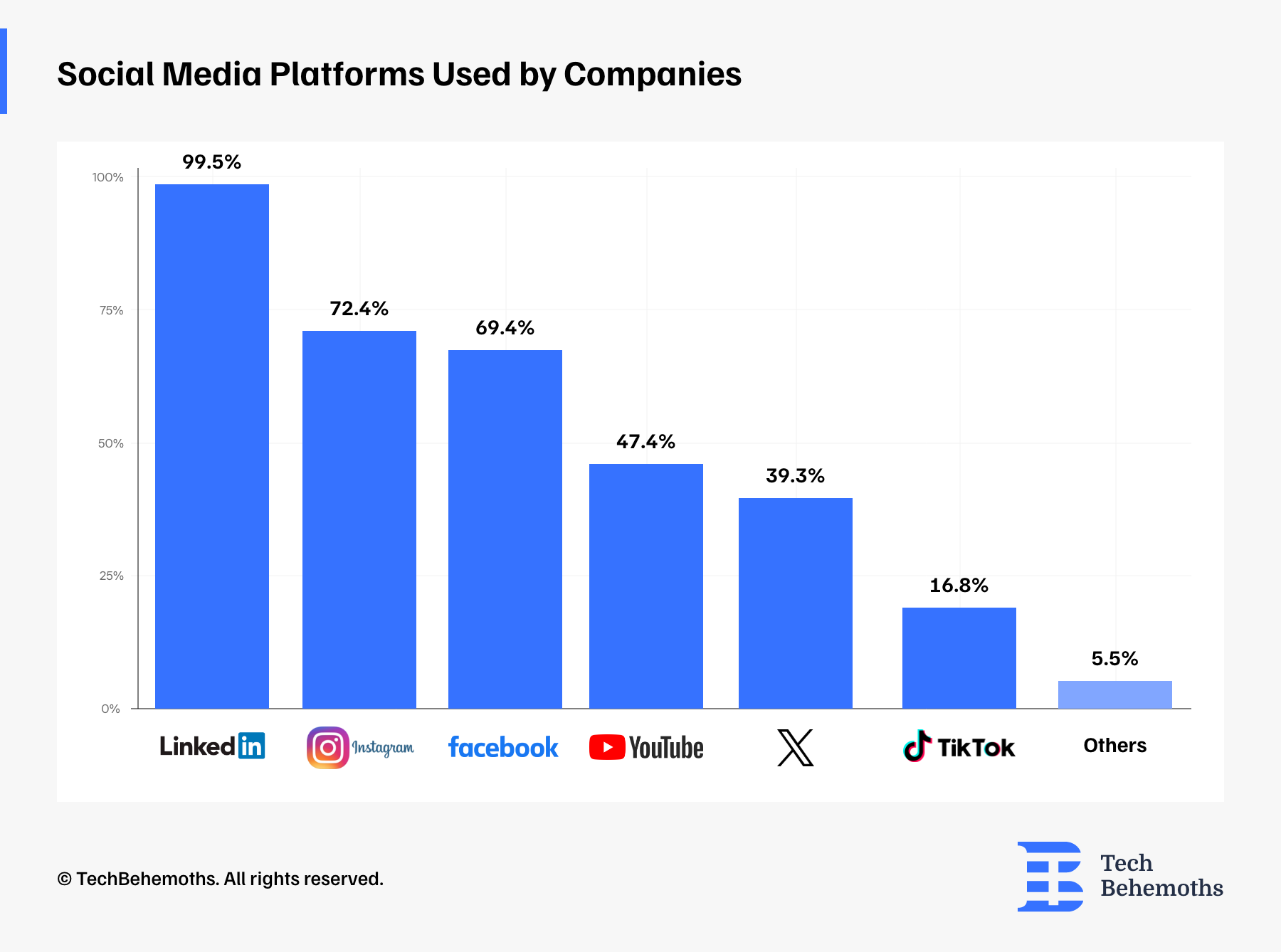
When Companies Started Using Social Media
Most companies have used social media for several years, showing how important it is for business communication.
More than half (53.6%) started using social media between 4 and 10 years ago. This indicates that businesses began to adopt it more in the mid-2010s as it became essential for visibility.
A smaller group, 14.8%, has over a decade of experience, making them early adopters who included social media in their strategies long before it became common.
Additionally, 22.9% began using social media in the last 1–3 years, showing that new businesses see the value of having a digital presence.
Only 8.2% joined within the past year, and just 0.5% reported not using social media at all.
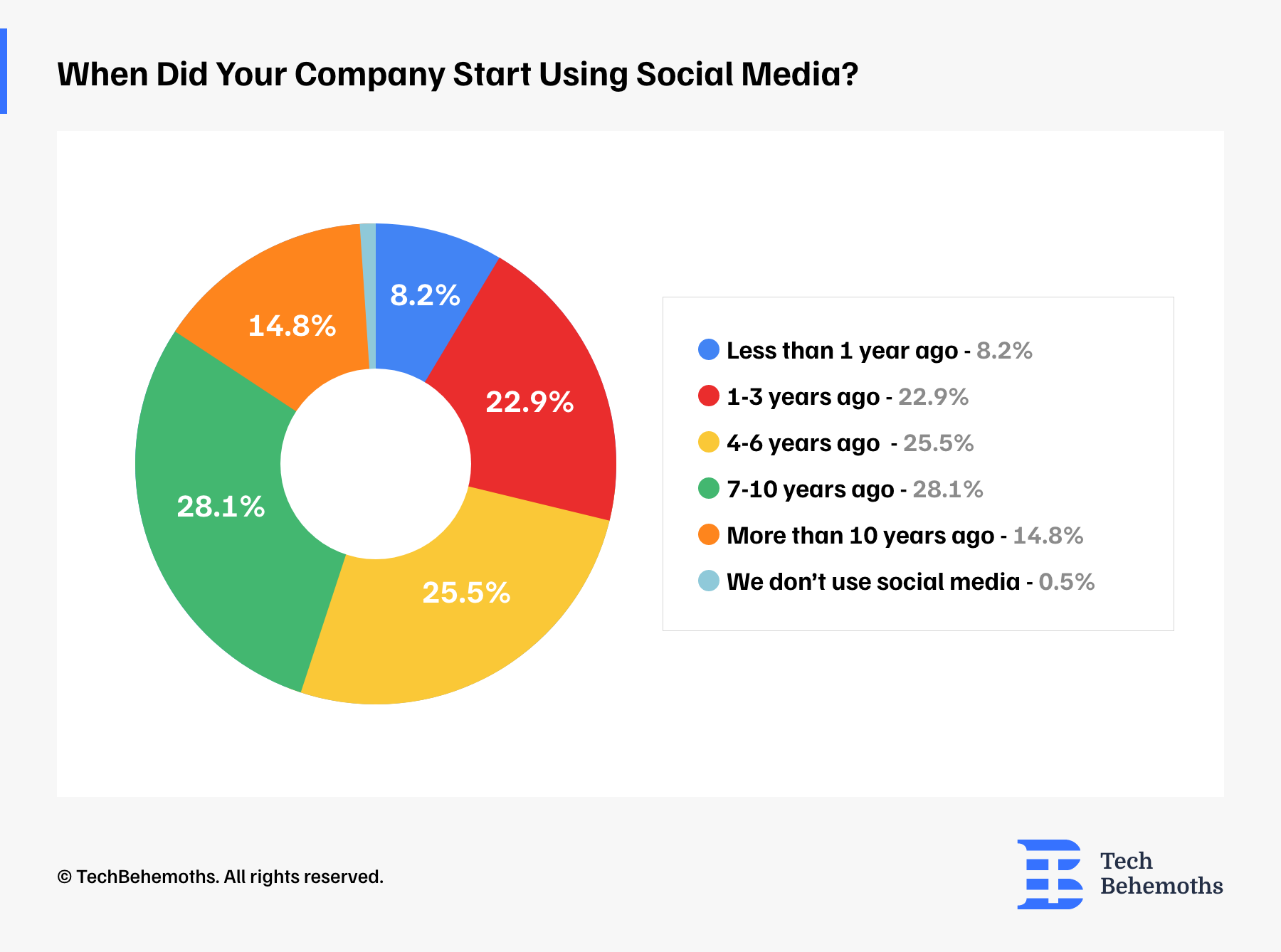
Why Companies Use Social Media?
The survey results show that companies use social media with clear goals.
Brand awareness is the top priority at 90.3%. This means most businesses consider social platforms essential for visibility and recognition.
Lead generation comes next at 71.4%, highlighting how social media helps with growth and new business opportunities. Customer engagement and community building are also important at 52.6%. Companies want to interact with their audiences to build stronger relationships.
More direct goals, like sales and conversions at 36.2% and recruitment and employer branding at 35.2%, show that while social media can support transactions and talent acquisition, its main strength lies in raising awareness and building connections.
“We aim to use social media to share value, build trust with our audience, and position ourselves as a reliable software solutions partner.”
CodeCapital Team
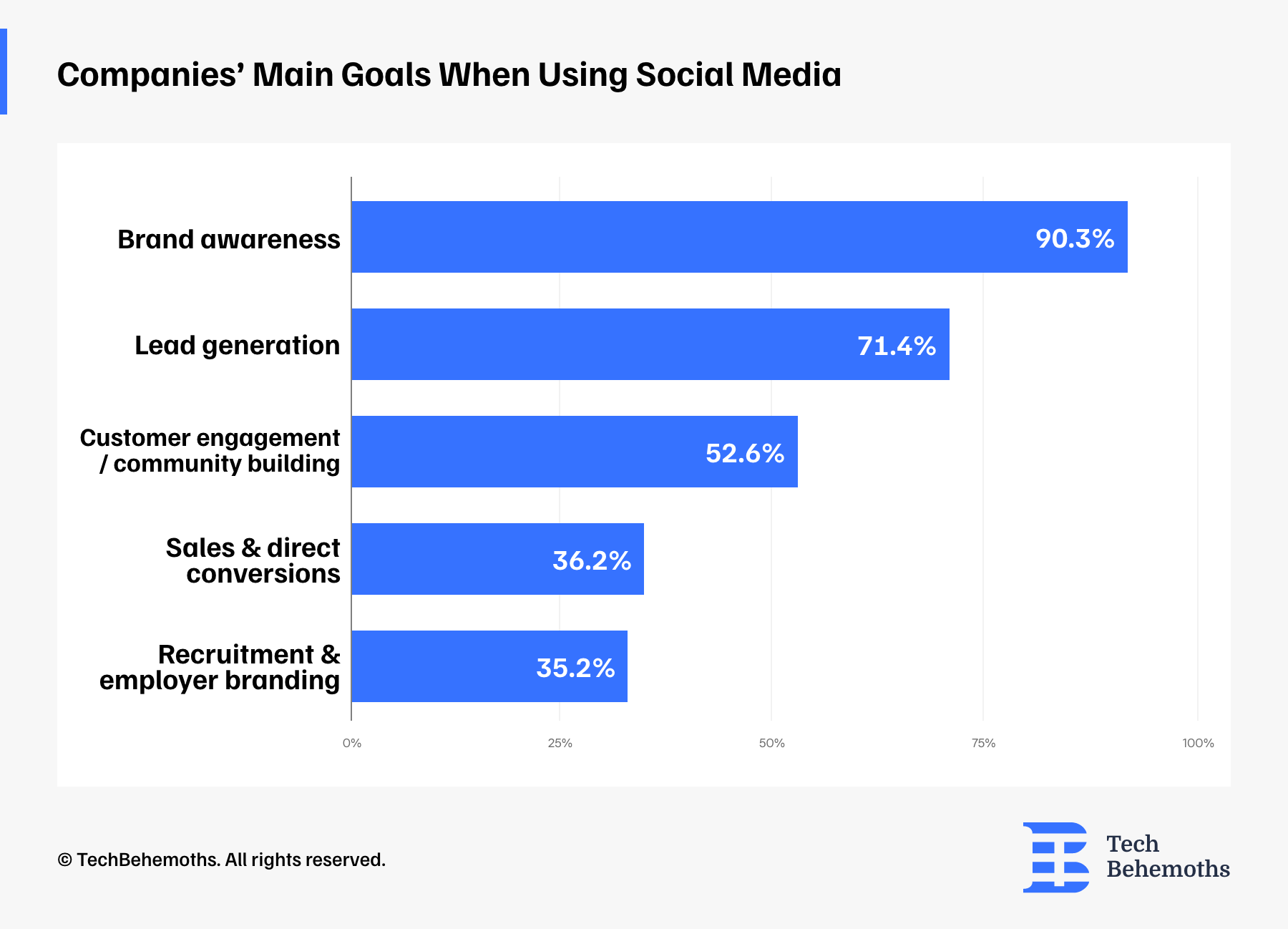
56.1% of Companies Manage Their Social Media In-House
In response to the question of who manages company social media, 56.1% is handled by in-house marketing teams and 38.3% by founders or CEOs.
Smaller shares rely on dedicated social media managers (16.8%), other employees (14.3%), or external agencies (6.6%), while only 3.1% report no active management.
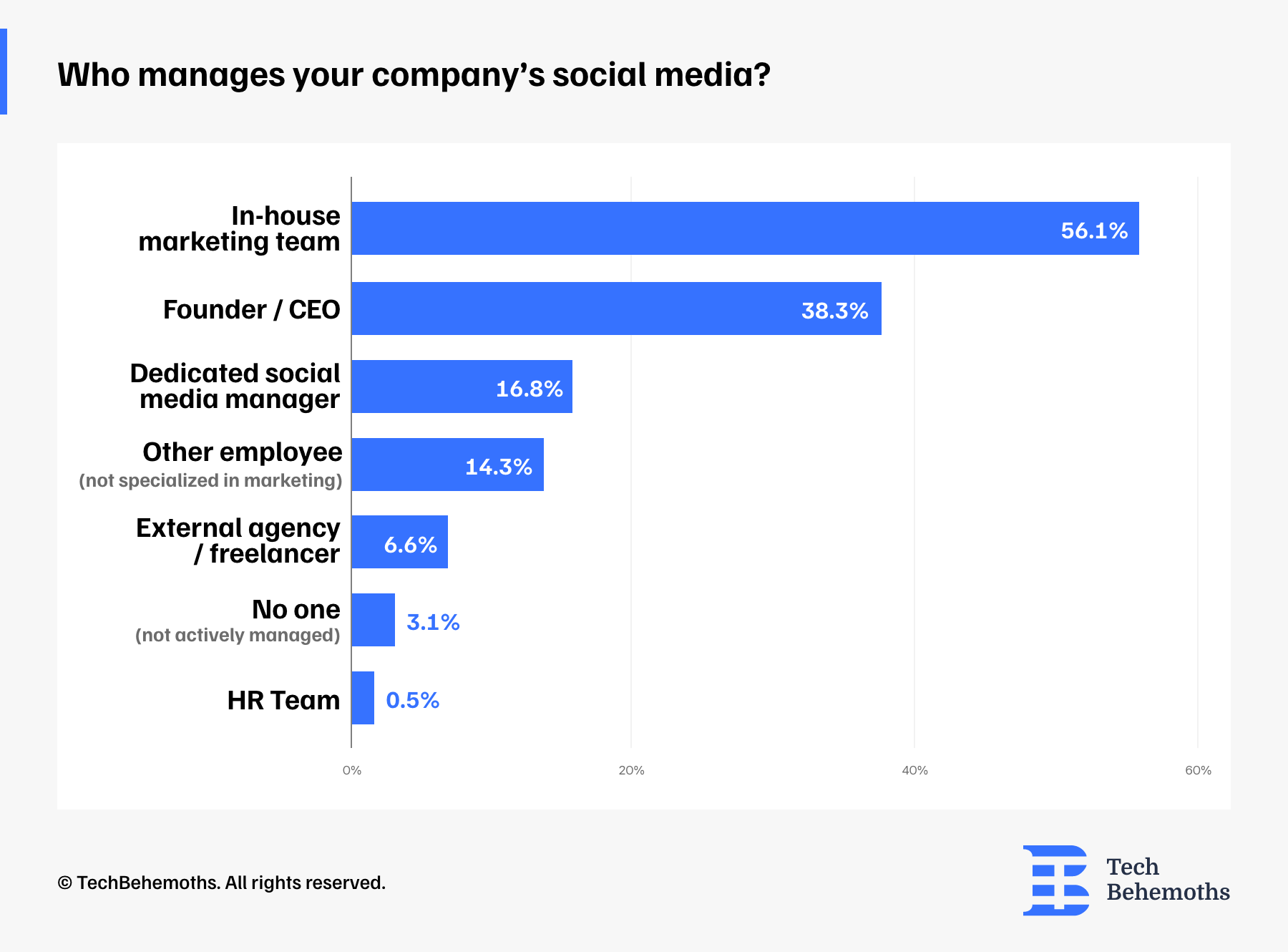
Over Half (51%) of Companies Rely on 2–3 People to Manage Social Media
The survey shows that social media is largely managed by small teams, with over half (51%) assigning the task to 2–3 people. Another 32.1% rely on a single person, highlighting the limited resources of small teams dedicated to this area.
Larger teams, 11.2% involve 4–5 people, while only 3.1% have more than five. Notably, 2.6% of companies have no one managing social media, signaling missed opportunities in visibility.
Overall, the data shows that most businesses handle social media with limited but focused resources.
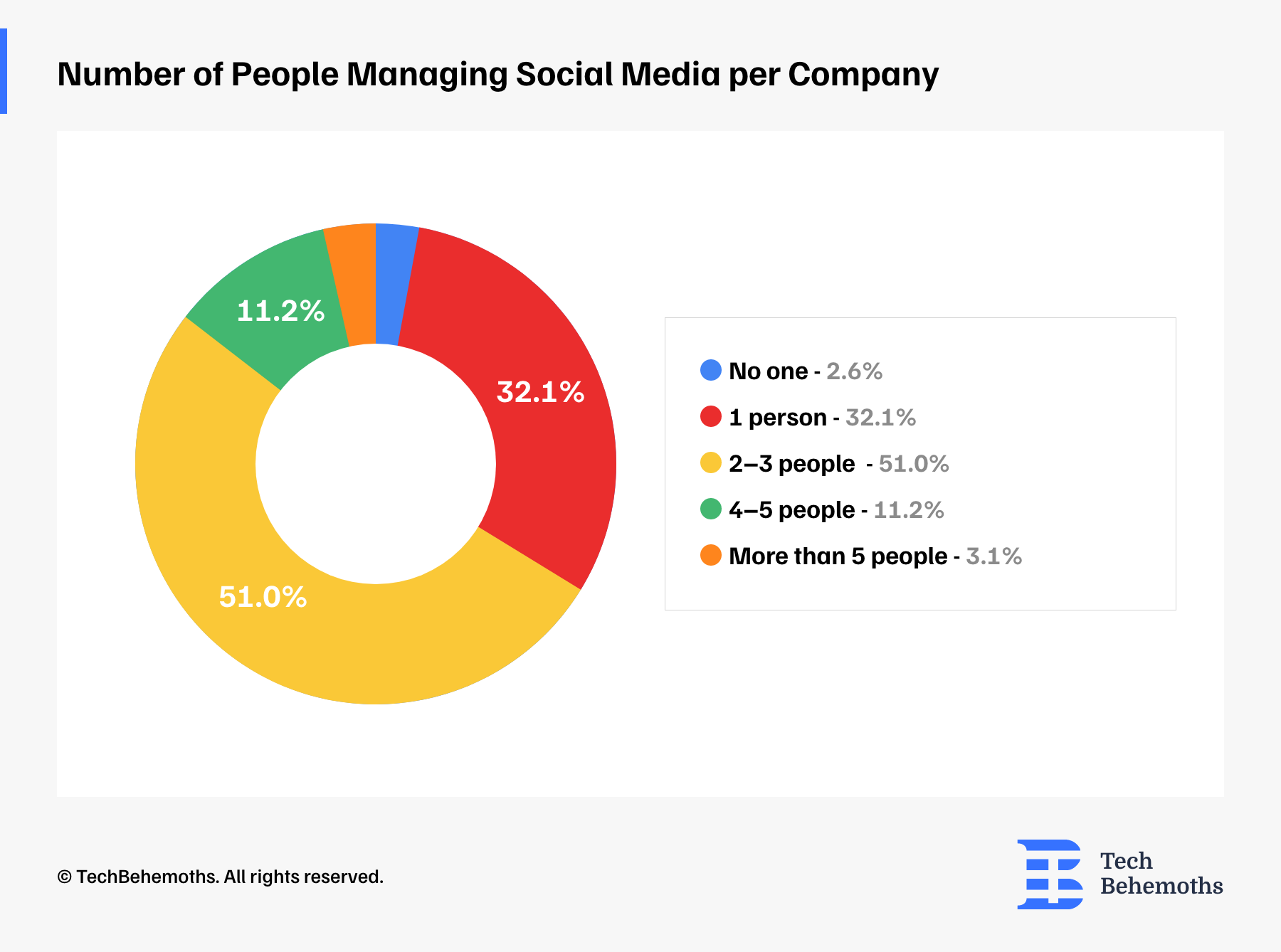
How Often Companies Post on Social Media?
When asked how often companies post on social media, over half (52.6%) told us they post weekly. About 20.9% post daily, which shows they are actively engaging with their audience and staying relevant.
By contrast, 10.7% post monthly and 15.8% post rarely. This suggests that for some businesses, social media remains a secondary channel rather than a core strategy.
The data also shows how often companies post varies based on their priorities and resources. While regular posting is common, the frequency depends on what each company values and can afford.
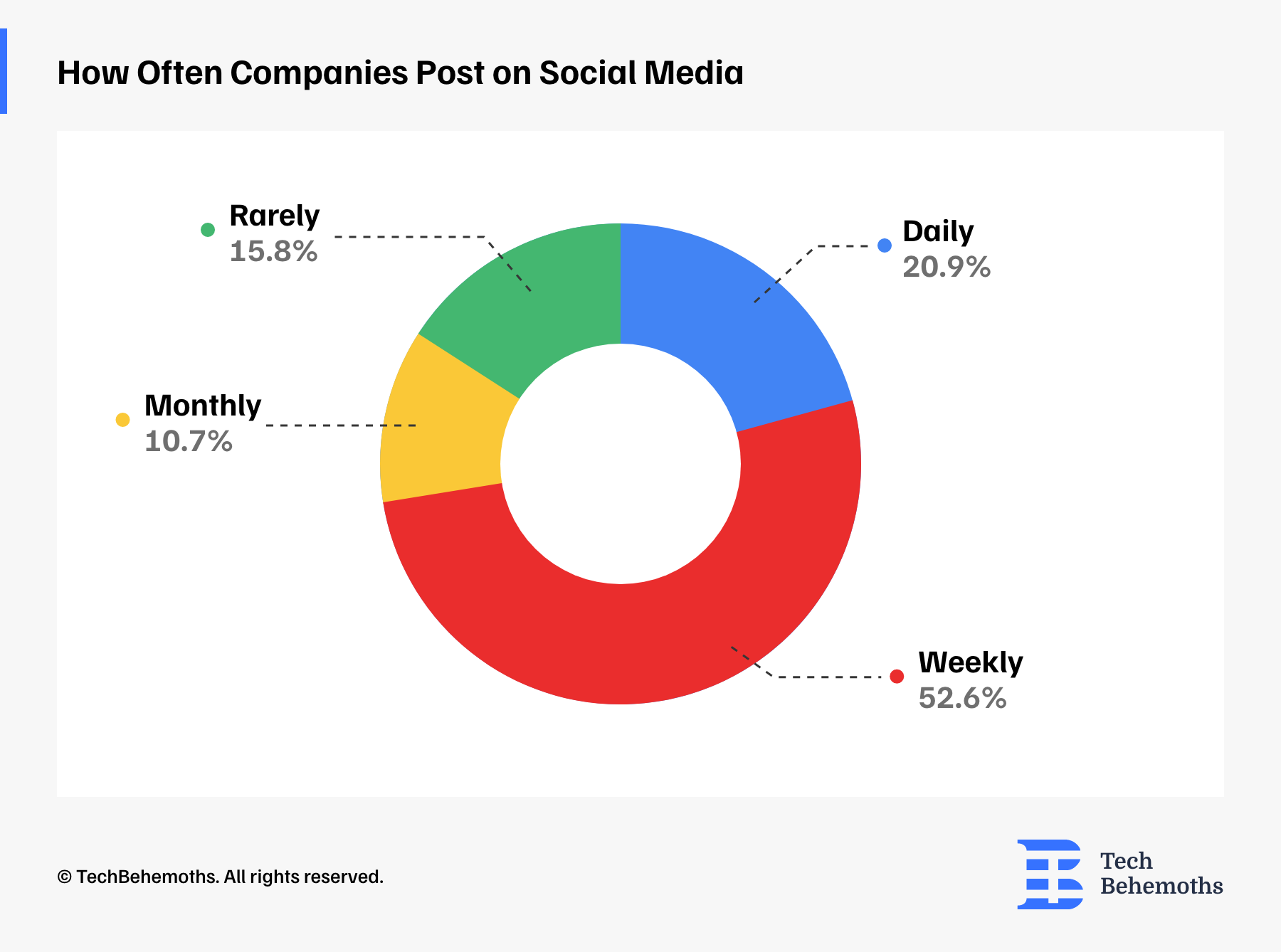
Content That Works Best for Audiences
Written content leads, but visuals and short videos are catching up
The survey data shows that articles and blog posts are the most effective type of content, chosen by 72.4% of companies. This underlines the value of in-depth, informative pieces that build credibility and support long-term engagement.
Static images follow at 61.2%, showing that simple visuals are a reliable way to grab attention and convey messages quickly. Nearly half of companies see strong results with short-form video (49%) and infographics (46.4%), as both provide engaging and easy-to-understand information.
On the other hand, long-form videos (17.9%) and stories (14.8%) are less popular, indicating that, while they can appeal to specific groups, they are not central to most content plans.
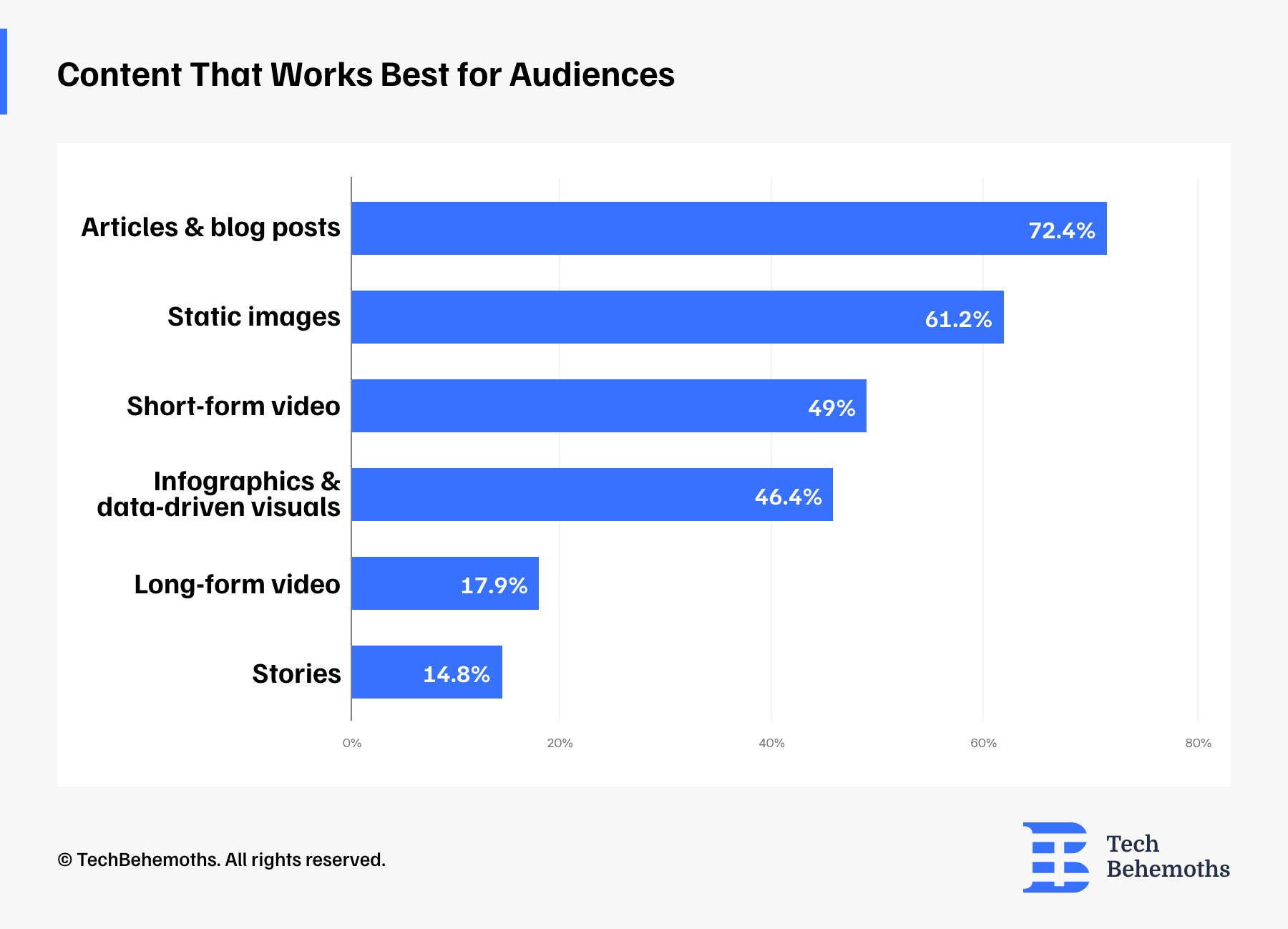
Publishing Strategies on Social Platforms: Planning vs. Spontaneity
When asked how they usually publish content on social media, companies reported a variety of approaches:
- 32.1% mix planning with spontaneous posts.
- 26.5% schedule content in advance using tools.
- 26.0% plan manually without tools.
- 15.3% rely mostly on live, spontaneous posting.
This shows that most companies appreciate having a plan while still allowing some flexibility.
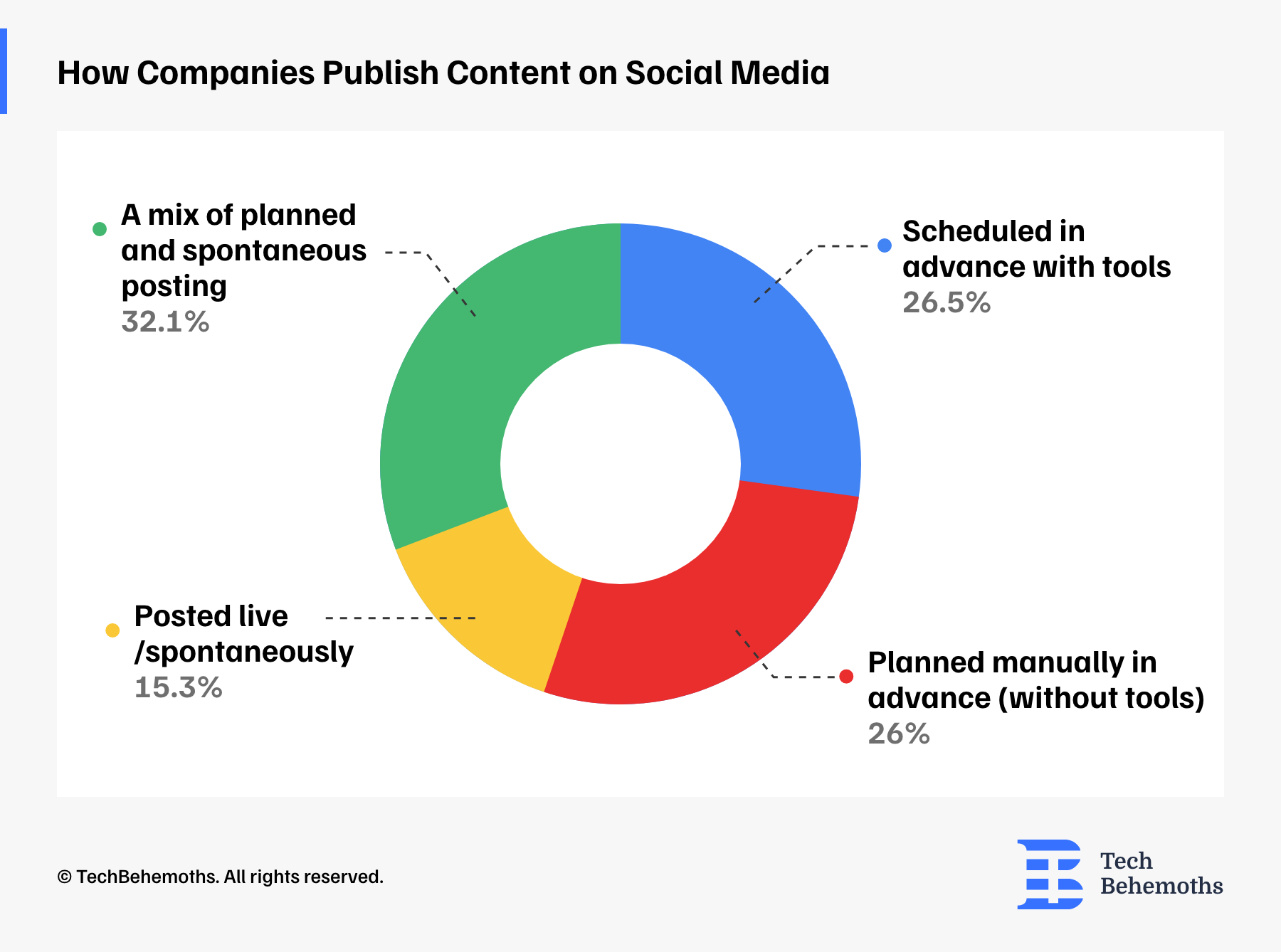
Tools Used to Plan or Schedule Social Media Content
According to our survey, most companies manage their social media manually, with “None” being the leading choice for all platforms.
On LinkedIn, 54.2% of respondents post without using any tools, while Buffer (14.8%) and “Other” tools (24.6%) are secondary options.
Instagram and Facebook show a similar trend, with around half of companies (49% and 47.3%) not using scheduling tools. However, Meta Business Suite plays an important role here, adopted by 24.5% on Instagram and 27.3% on Facebook.
YouTube and TikTok stand out with very high manual management rates (77.3% each). For TikTok, 8.4% use Later, and for YouTube, 5.6% use it too.
On X (Twitter), nearly three-quarters (74.9%) also manage content manually. Buffer is used by 7%, and other tools like Hootsuite and Sprout Social are used by 12.6%.
Concluding here, between 47% and 77% of companies on these platforms do not use scheduling tools. Some companies select tools like Buffer, Later, or Meta Business Suite based on their needs.
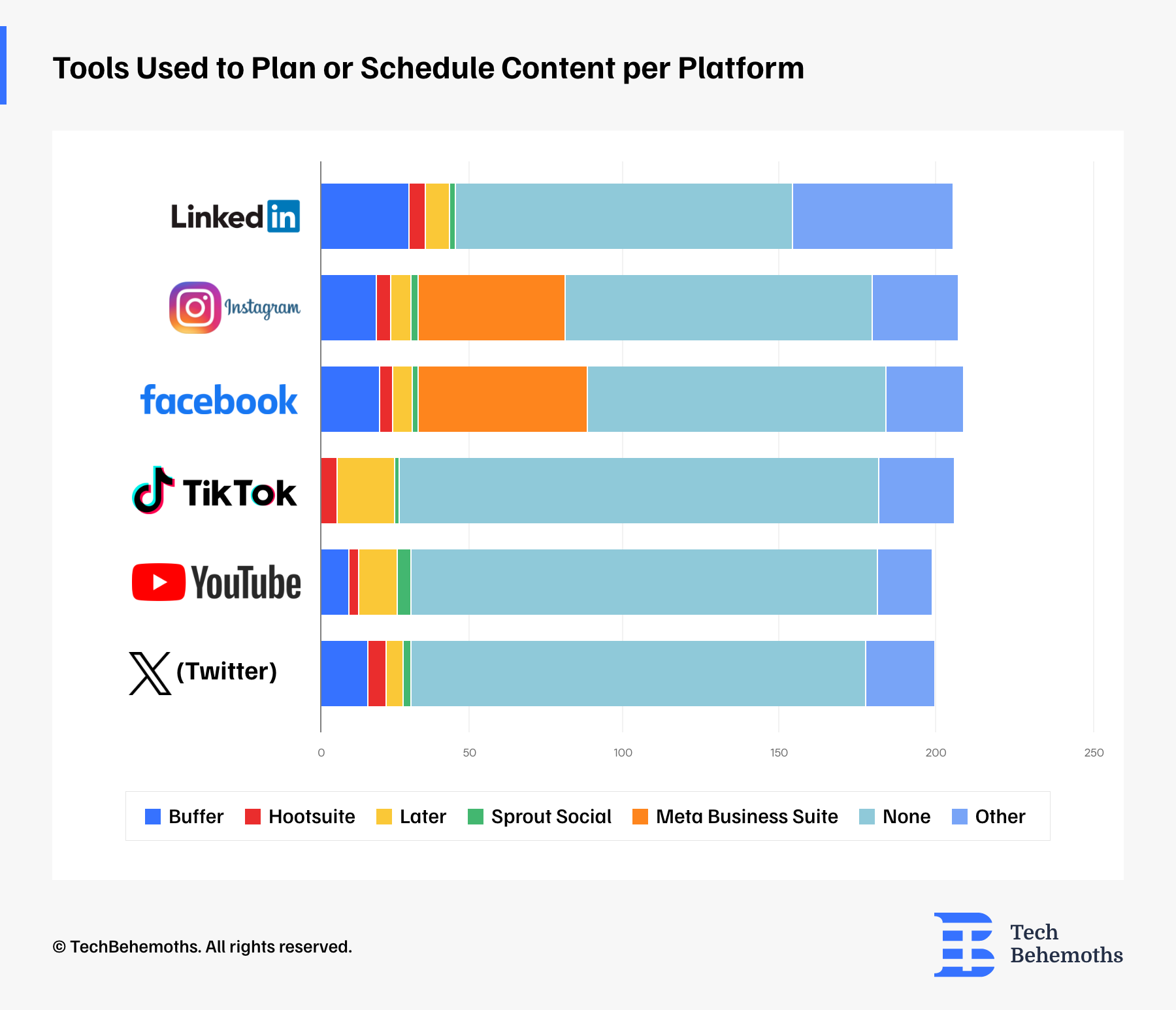
Do Companies Use AI Content on Social Media?
In response to the question of how often companies use AI Content on social, most (59.7%) reported using AI occasionally, mainly to support specific posts rather than as a primary content source.
A smaller share - 14.3% rely on it for most of their content. At the same time, 17.9% say they never use AI, and 7.1% apply it rarely, only for tests or experiments.
Just 1% remain uncertain about their use. Companies value AI as a helpful tool, but not yet dominant in social media strategies.
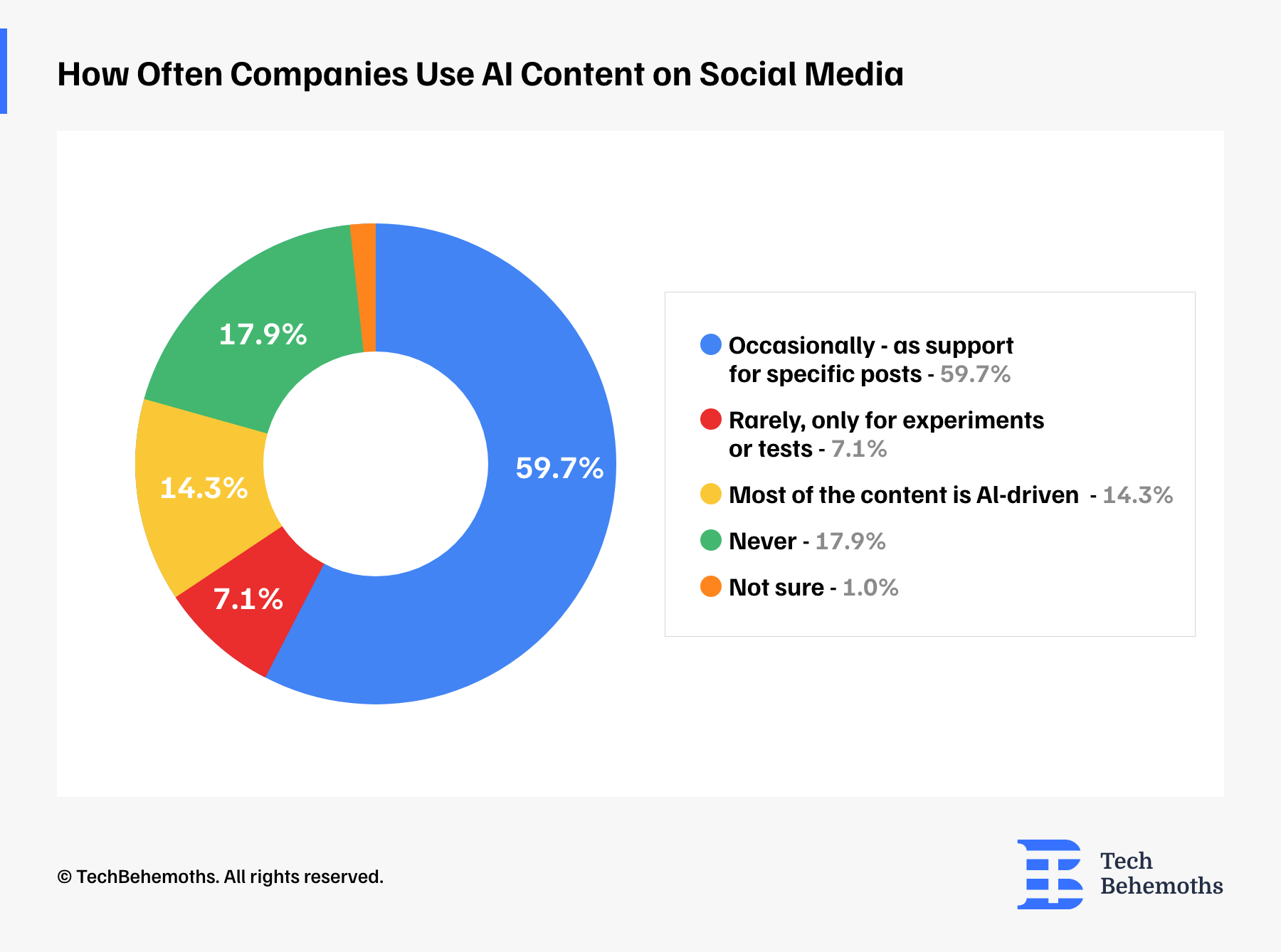
Organic Reach or Paid Advertising?
When asked about their approach to social media, 71.9% of respondents showed a clear preference for building visibility through content and engagement. Only 2.6% focus mainly on paid advertising, indicating that few see it as their primary strategy.
21.9% combine both approaches, balancing reach and targeted promotion. And a small share (3.6%) is not active on social media at all. Overall, organic presence remains the dominant strategy, with paid advertising used selectively.
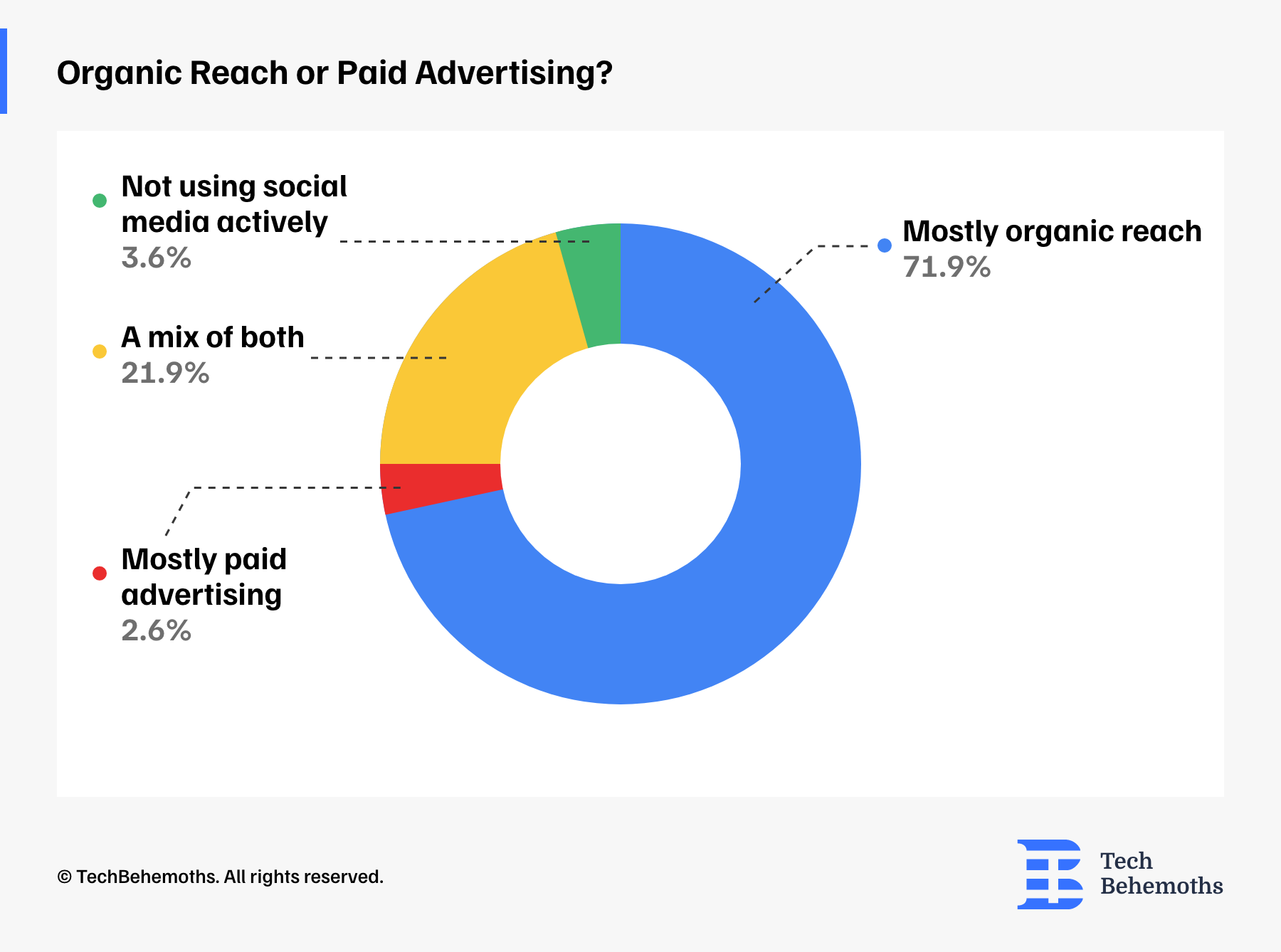
49% Say Organic Reach Is Most Effective
Respondent companies pointed to organic reach as the most effective social media strategy, with 49% supporting this approach. In contrast, 13.3% believe that paid advertising drives better results. This smaller percentage suggests that while ads can improve visibility, they are not trusted as the only strategy.
About 17.3% see both organic and paid approaches as equally effective, indicating that a combination works best for some businesses. Meanwhile, 20.4% are unsure or cannot measure effectiveness, highlighting the difficulty many have in tracking ROI and aligning social media efforts with business goals.
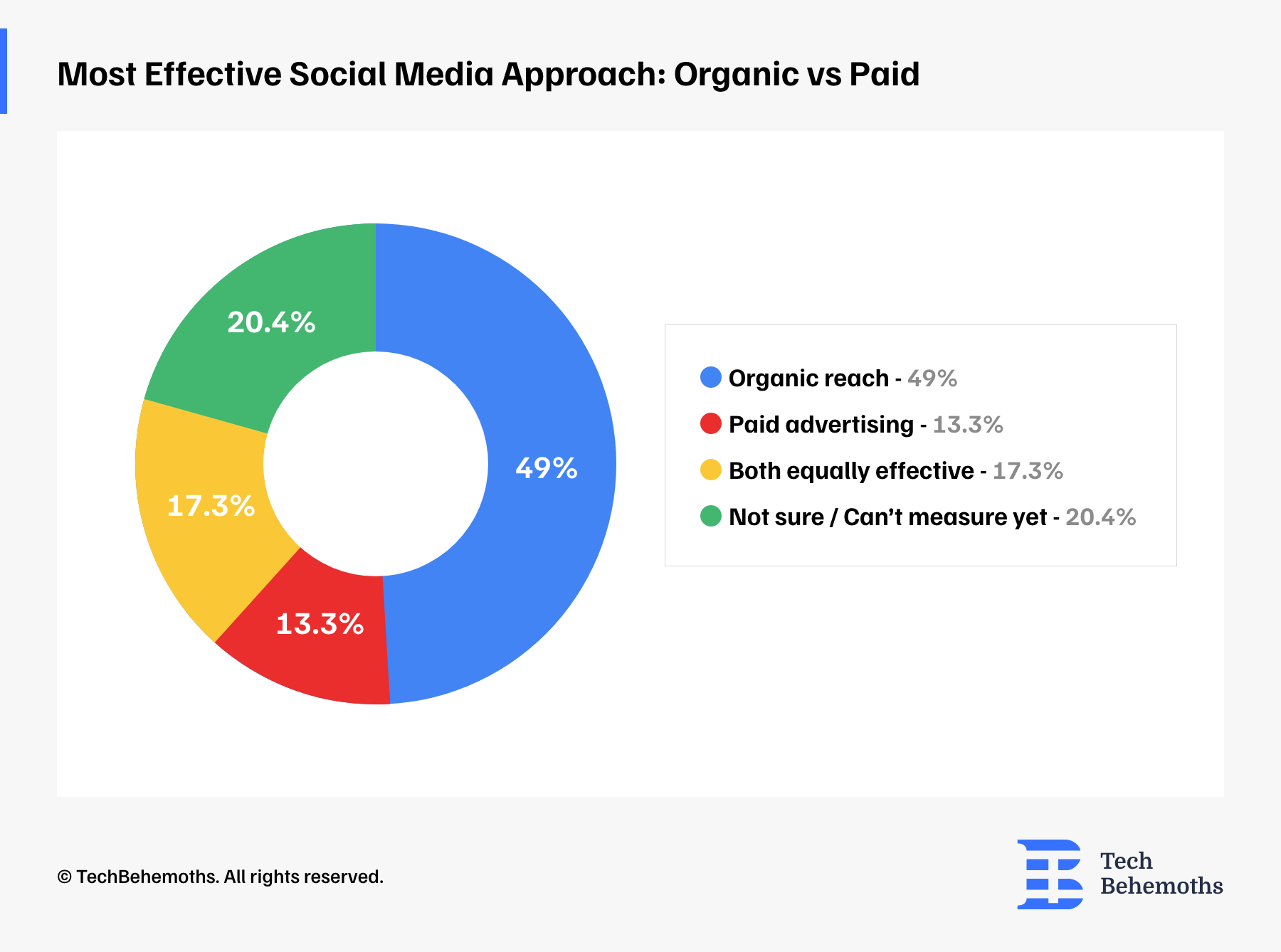
How Companies Engage With Their Communities on Social Media?
Survey results show that responding to comments and messages is the most important online engagement activity, with 90.8% of companies prioritizing it. Timely and professional replies are key to connecting with customers.
About a third of companies also use interactive methods, like polls, Q&As, or quizzes (36.7%), and sharing user-generated content (32.1%) to encourage conversation and show customer opinions.
Less common strategies include working with followers (15.8%), running contests or giveaways (10.2%), and hosting live sessions (9.2%). These methods are engaging but require more planning and resources.
Only 1.5% of companies reported no engagement at all, suggesting that nearly all businesses value active interaction with their community.
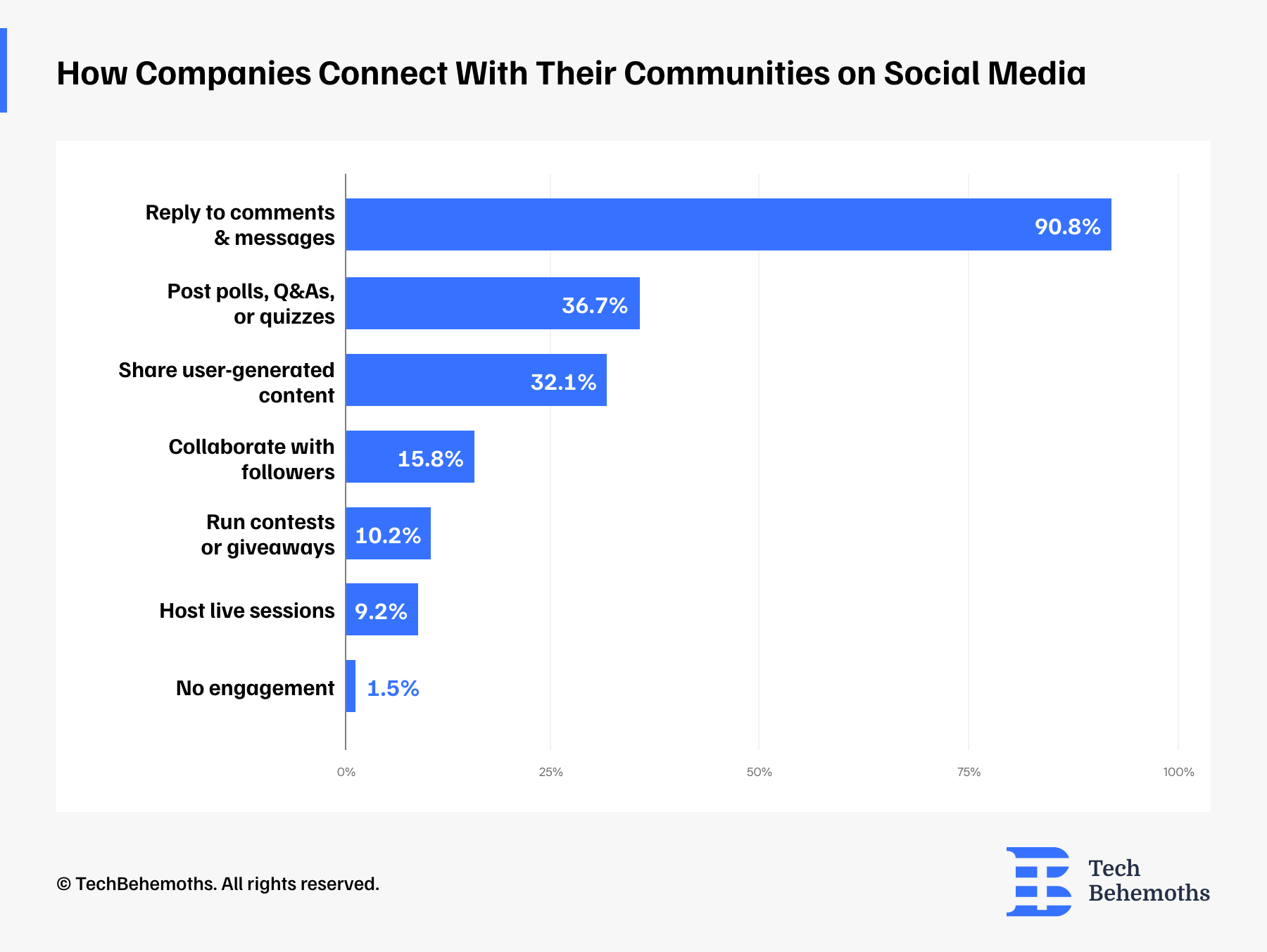
How Companies Handle Negative Feedback on Social Media?
When it comes to handling negative feedback on social media, most companies (76%) choose to respond publicly in a professional way, turning criticism into an opportunity to demonstrate transparency and care. A small share prefers more discreet approaches, with 6.1% responding privately through direct messages or email.
Some companies take a different approach: 7.1% ignore negative comments, while 5.6% delete or hide them. Thus, it is evident that most companies value public professionalism, considering it the best way to maintain trust.
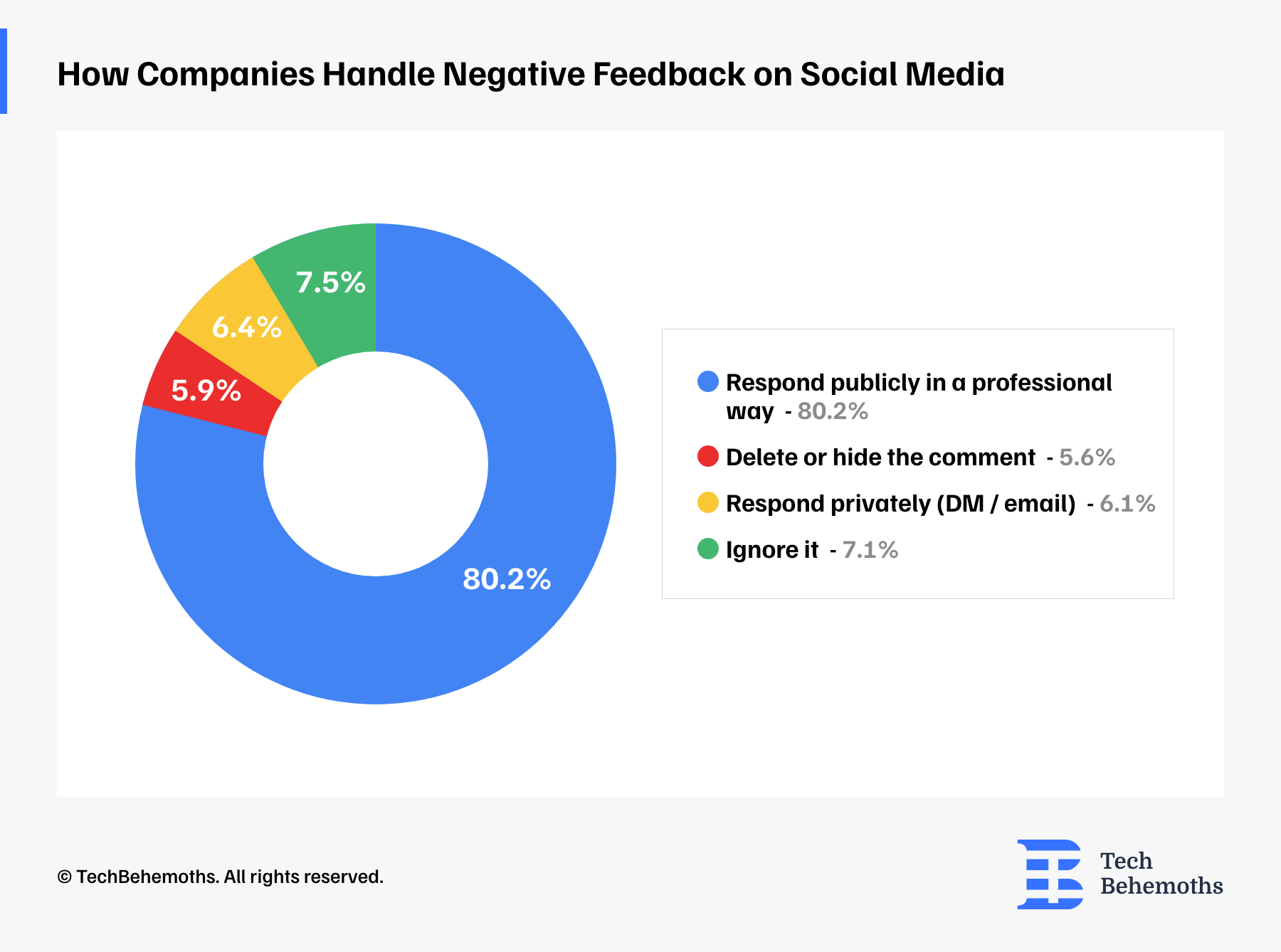
How Companies Measure Social Media Success?
Measuring what matters on social media, the survey reveals that businesses put their focus on:
- Engagement (69.4%) includes likes, shares, and comments that indicate how much the audience interacts with a company's content
- Reach and impressions (60.7%) highlight the need for content to be visible to the right audiences.
- Website traffic (60.2%) shows how social media helps direct users to company websites and encourages conversions.
- New followers (56.1%). Gaining new followers is important for growing the audience.
Interestingly, only 2% of companies say they don't measure their social media results at all.
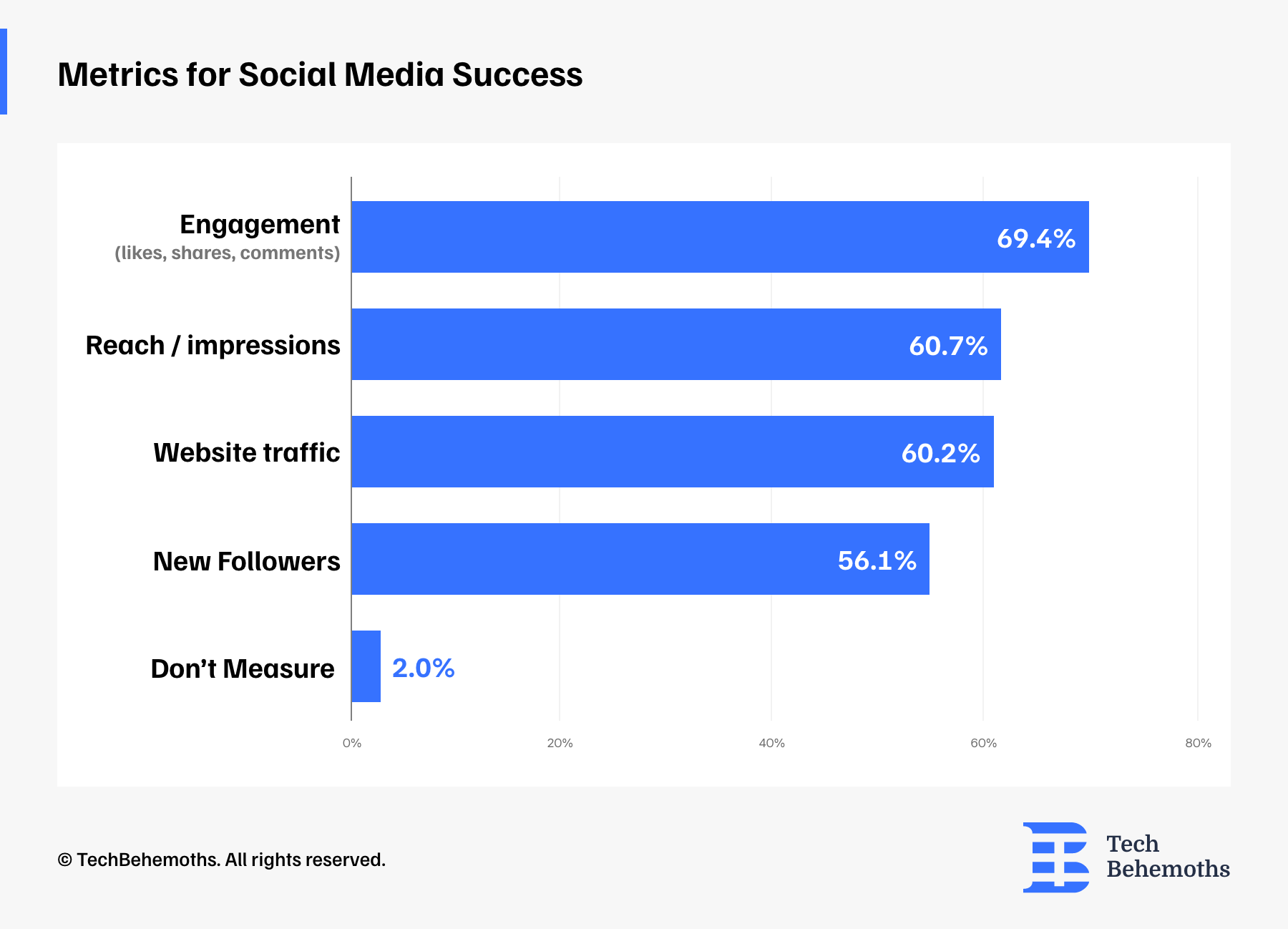
Time, Money, and Ideas: The Challenges Behind Social Networks
When asked about the biggest challenges in managing social media, 50% of companies mentioned a lack of time, making it the most common barrier to consistent activity. The second most common issue is limited budgets, mentioned by 40.3%. This affects spending on content creation, advertising, and professional tools.
Around a third of companies also face challenges with algorithm changes (31.6%), lack of content ideas (31.6%), and difficulty measuring ROI (31.1%). These factors show that changing platform rules and unclear performance metrics make long-term planning difficult.
Additionally, 25% of companies struggle to keep up with new trends, reflecting the fast pace of the digital landscape. Only 2% pointed out other issues, emphasizing that time, money, creativity, and measurement are the main difficulties most businesses encounter in their social media strategies.
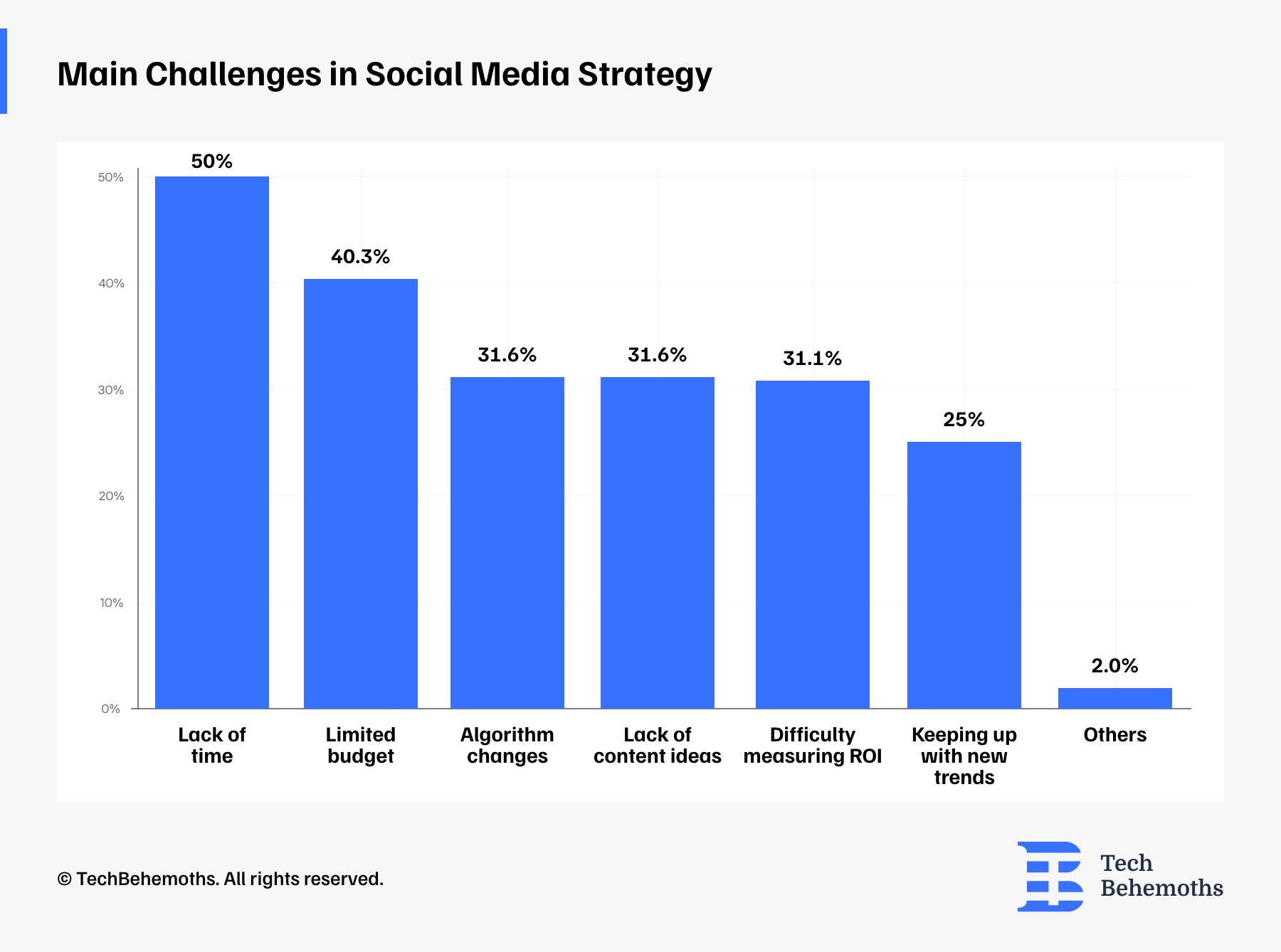
2026 Content Marketing Priorities
In 2026, companies will focus on blogs and articles (31.6%) as their top content format. They value these formats for credibility, search engine optimization (SEO), and long-term visibility. Short videos (29.4%) are a close second, showing the growing demand for quick and engaging content on social media.
Infographics (15.2%) are still popular for making complex ideas easy to understand, while long videos (12.9%) are used for detailed storytelling and tutorials. Stories (11.7%) play a smaller role, providing interactive and time-sensitive ways to connect with audiences.
These results indicate that firms are planning to balance the need to establish authority with written content and to attract attention with dynamic visuals.
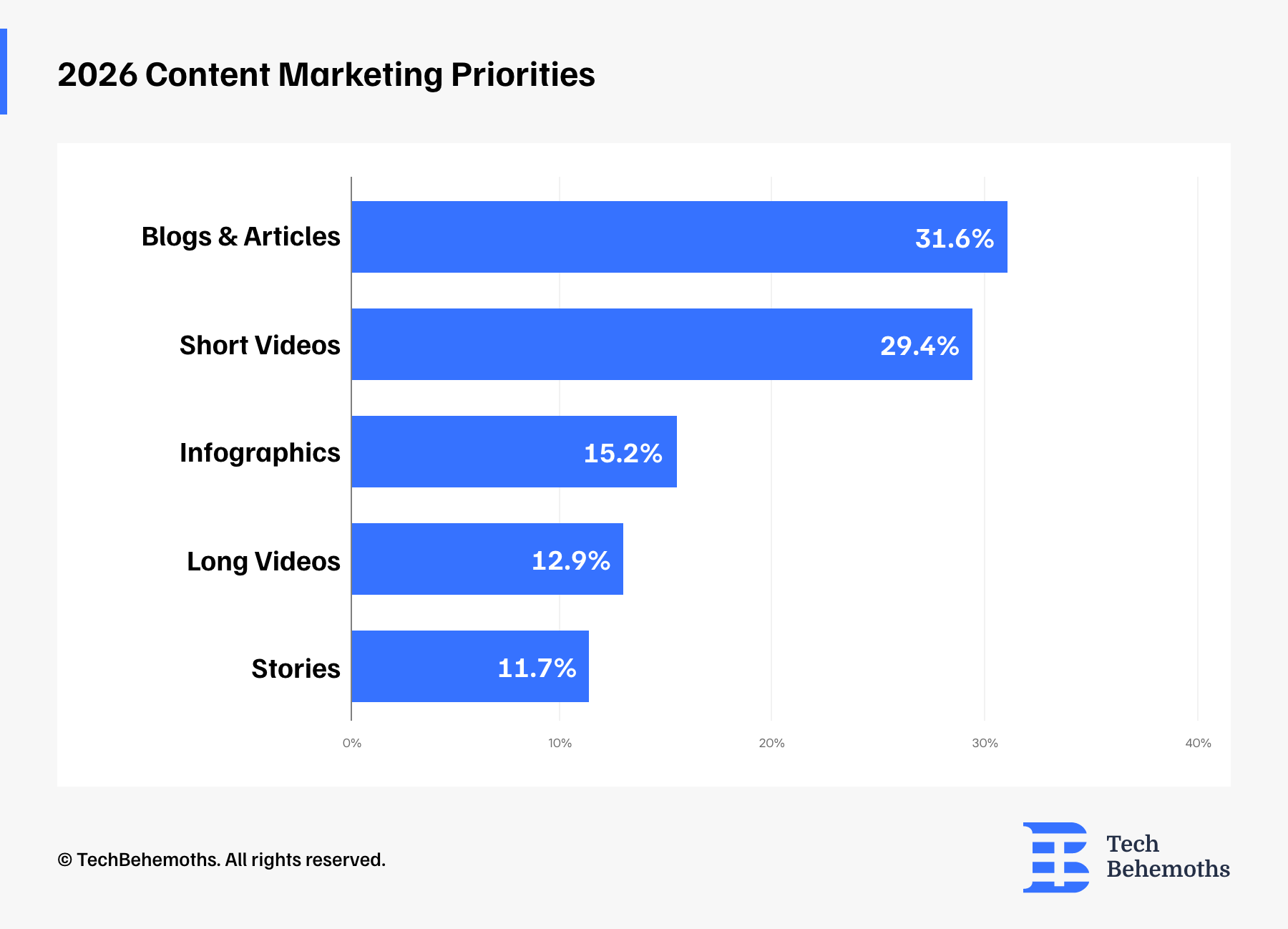
Social Media Trends That Matter Most in 2026
AI & personalization will matter most for us in 2026, as it enables scalable yet tailored engagement with healthcare and technology audiences, while supporting compliance-driven communication.
Survey Respondent
Survey data shows that in 2026, most companies (81.6%) see artificial intelligence (AI) and personalization as the top trends in social media. This indicates a shift towards using data to create smarter content tailored to individual audiences.
In comparison, other trends like paid ads (7.1%), micro-influencers (4.1%), social commerce (3.1%), and AR/VR (2.6%) received much less attention. Even though businesses are aware of the new tools, they are mainly focused on using artificial intelligence to improve targeting, engagement, and customer experience.
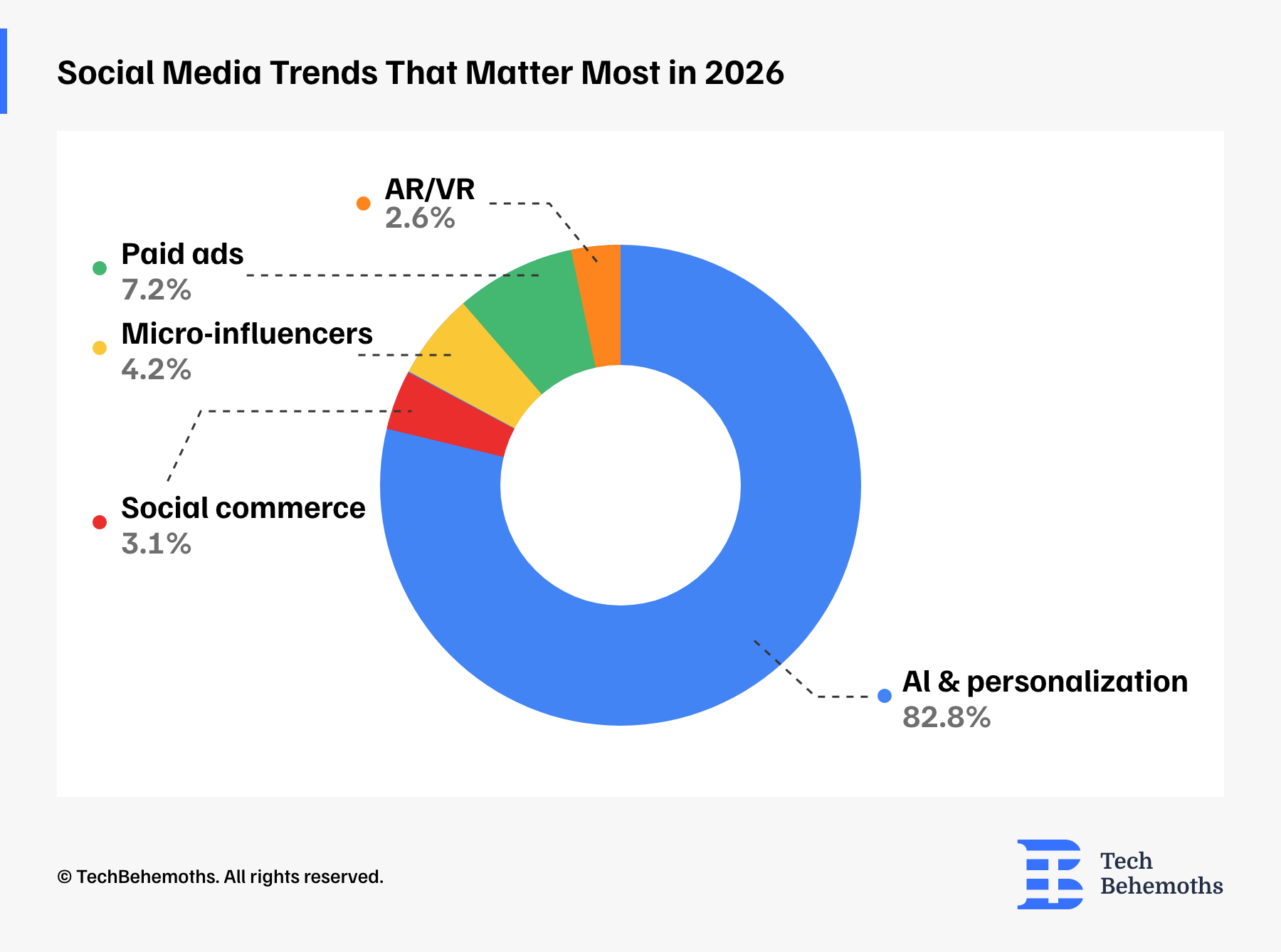
How Effective Is Each Platform?
We wanted to find out which platform works best for small and medium-sized businesses. The results show that LinkedIn is the top choice. Most respondents say it is “effective” or “very effective” for professional networking and B2B visibility.
Instagram and Facebook have mixed results. Many businesses see value in them, but a large number rate them as only slightly or moderately effective. This indicates that these platforms perform better when combined with strong content strategies.
YouTube falls in the middle; about one-third of respondents find it moderately effective, while others see it as effective. This highlights both the potential and struggles of using video, which can be resource-intensive.
On the other hand, X (Twitter) and TikTok are viewed as the least effective. Many companies rate them low or mark them as not applicable, suggesting they are not relevant for most small and medium-sized businesses.
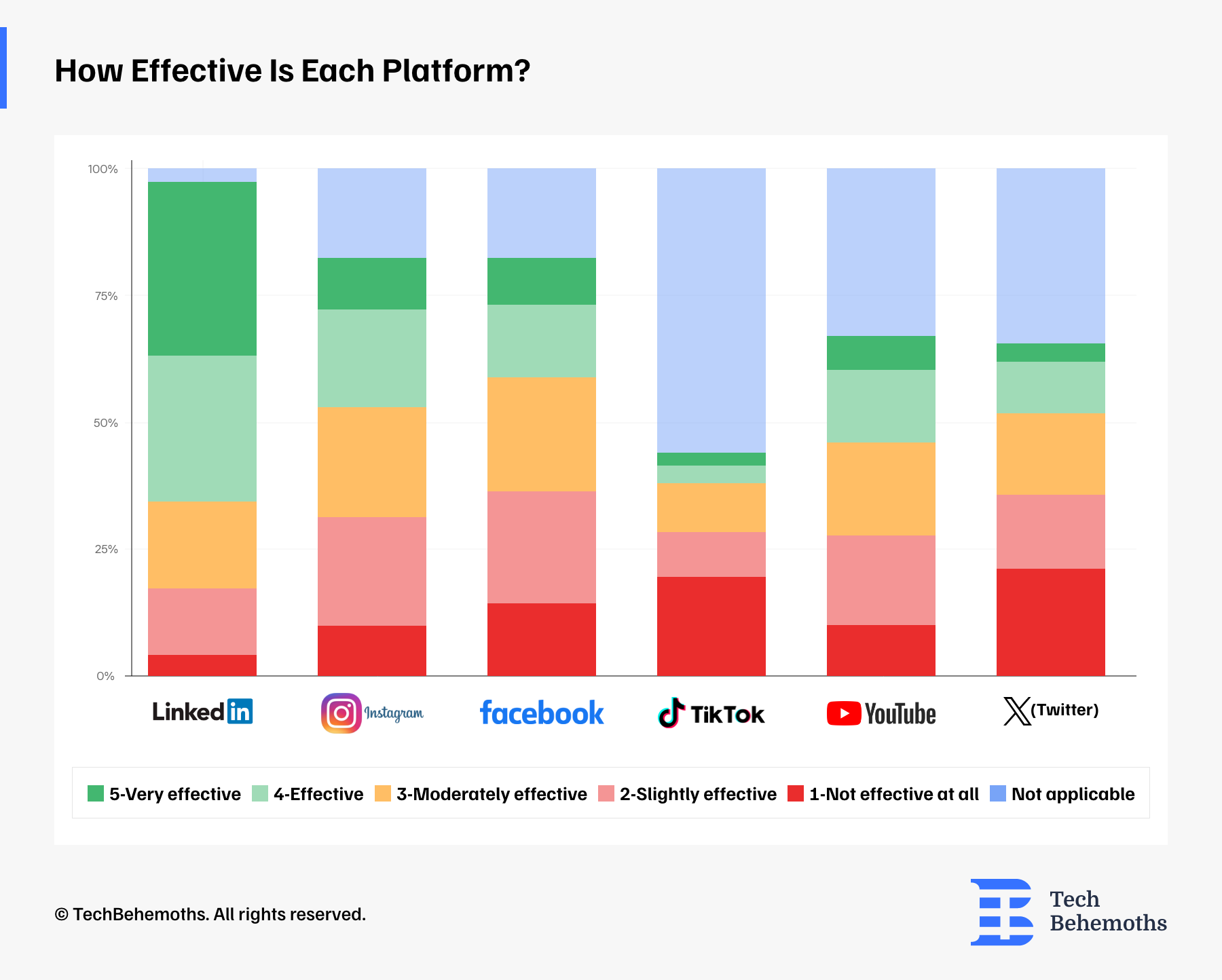
In Conclusion
The survey results make one thing clear: social media is now essential for visibility, engagement, and growth. LinkedIn stands out as the most effective platform for professional networking and B2B, while Instagram, Facebook, and YouTube serve as valuable secondary channels depending on content type and audience.
Companies favor organic reach and plan to invest more in blogs, articles, and short videos, while also embracing AI and personalization as the next big trends. Despite challenges such as limited time, budgets, and a fast-changing digital landscape, businesses continue to view social media as a cost-effective way to build trust, generate leads, and strengthen their presence.
For SMBs, success lies in choosing the right channels, delivering consistent value, and staying adaptable to change. The only question left — where will your audience find you tomorrow?
Looking for expert help to grow your brand on social media?
Check our list of top Top Companies providing SMM services
Partner Companies
Our survey reached IT companies and web agencies all around the world, with no limits on region or country. In total, 1960 companies from 53 countries took part. A big thank you to our partner companies who helped spread the word and made these valuable insights possible.
- Polcode, Poland
- Kaopiz, Vietnam
- Inviggo, Serbia
- Mahé Technologies, Mauritius
- Shortcut Asia, Malaysia
- Selector Digital Marketing Agency, Hungary
- PRAS, Poland
- LL Technolab Pvt. Ltd., India
- dhero.studio, Romania
- Fuse Web BV, Netherlands
- Atta Systems, Romania
- foxcode, Oman
- Yaali Bizappln Solutions, India
- Bartoňová, Czech Republic
- HaulMar LLC, Kyrgyzstan
- Team VISION Bulgaria, Bulgaria
- Itentio IT Recruitment, Poland
- NBW Internet Wizards, Greece
- Timspark, United Kingdom
- Wave Evolution, Malaysia
- Datum Decipher Analytics, India
- HUSPI, Poland
- division5, Albania
- AskGalore, United States of America
- Seedium, Estonia
- Zluck Solutions, India
- Corpela Inc, Pakistan
- DevIT Group, Ukraine
- NexCrafters, United Kingdom
- Kevych Solutions, Ukraine
- dev.family, Portugal
- AVS Solutions, Serbia
- GITS, Vietnam
- IT Services Based Mid level, India
- Technostacks, India
- Tanosec Cybersecurity, South Africa
- Dreambit, Ukraine
- How Animation Studio, Poland
- Ahmedabad interior designer, India
- Komplyzen, Germany
- Versada, Lithuania
- Umbrella IT, United States of America
- Maxlence Consulting, Australia
- Loopstudio, Uruguay
- Step2gen Technologies, India
- NFN Labs (OPC) Pvt Ltd., India
- iRoid Solutions, India
- Disruptive Digital, Singapore
- PowerGate Software, Vietnam
- a-devgroup, Ukraine
- Naturaily, Poland
- World Web Technology Pvt. Ltd, India
- Marketing21 Online Marketing Agency, Hungary
- Eklib Software, Canada
- Fusion Tech, Armenia
- OmniActus, Canada
- Fulfillment-Box, Germany
- Dirayaah Smart Technologies, Saudi Arabia
- NETK5, China
- Ekantik Technologies, India
- 5w155 SA, Switzerland
- Rocket House Pictures, United States of America
- IT GuidePoint Corporation, United States of America
- Glorium Technologies, United States of America
- Shunyavkash Private Limited, India
- Your Web Pros, United States of America
- Rablab, Canada
- PIXREADY, United Kingdom
- JetRockets, United States of America
- App Gurus, Australia
- OBI Services, Philippines
- BEON.tech, Argentina
- Budventure Technologies Pvt. Ltd, India
- launchOptions, Cyprus
- Designli, United States of America
- JohnCube, Poland
- SPD Technology, United Kingdom
- Communi, United States of America
- Kodesoft Technologies Pvt Ltd, India
- Crodymi LLC, United States of America
- Robomec Solutions, Saudi Arabia
- Key Software, Tunisia
- OVC, INC, United States of America
- Awata Technologies Limited, Nigeria
- SkyFig Technologies, Nigeria
- SEO Expert Gold Coast, Australia
- Sam King Web Design, United Kingdom
- ZAPTA Technologies, United States of America
- Plugincy, United States of America
- Skymit animation, Nigeria
- Wild Creek Web Studio, India
- Baltic Amadeus, Lithuania
- BugRaptors, United States of America
- XR Development | 3D Modeling & Animation, Canada
- *instinctools, Germany
- Digitalya OPS, Romania
- Rohallion, Scotland
- Forward Training & Consulting FZE, United Arab Emirates
- Junkies Coder, United States of America
- studio Akademia, Russia
- Genesis Technologies, India
- Relia Software, Vietnam
- Hipopotesis: Market Research for Better Strategy, Spain
- Fishing Frog Studio, Netherlands
- Red, United States of America
- BetterQA, Romania
- digitalkhargone.in, India
- Exemplifi, United States of America
- TechBehemoths, Germany
- Sinrorobotics, India
- Crystal Translation and Content Creation, Lebanon
- Hexabins, Sri Lanka
- Makeitfuture, Romania
- Wolfpack Digital, Romania
- ContentME, Egypt
- Turbo Digital Technology Consulting Ltd, United Kingdom
- Vanguard Tech Services, Oman
- InStandart, United Kingdom
- Eco-Soft Economic Software GmbH, Switzerland
- Thinkogic, India
- Neat Digital, Lithuania
- Lira, Armenia
- AltaCode, Armenia
- MobileXapps, Lithuania
- Geeks Ltd, United Kingdom
- IVN, Poland
- We Are The Missing Link Ltd, United Kingdom
- BroSolutions, Estonia
- End Point Corporation, United States of America
- SWOT Digital, Ireland
- NERDZ LAB, Ukraine
- GTS Translation Services, United States of America
- Differenz System, United States of America
- WidgiLabs, Portugal
- My Super Site, Bulgaria
- nostairway creative, United Kingdom
- IMAP Internet Marketing, Spain
- CodeCapital, Pakistan
- Elegant Digital Solutions (Pvt) Ltd, Sri Lanka
- Uinno, Ukraine
- Gecko Dynamics, Poland
- Manao Software, Thailand
- Akept, Nigeria
- Binmile, India
- Beech, Netherlands
- Vivasoft Ltd, Bangladesh
- Scalo, Poland
- Elint, Brazil
- Simple Code d.o.o., Croatia
- CloudX, United States of America
- SRG Group, Hungary
- TaxationPk, Pakistan
- Ledger Labs, United States of America
- Cloud Solutions, Bulgaria
- Epic Apps, United States of America
- Differenz System, United States of America
- RAMSCRIPT, India
- SoftTeco, Lithuania
- BeeWeb, Armenia
- UP2DATE Software, Romania
- Escolhadigital, Portugal
- Unstuck Labs, United States of America
- eMonster Solutions Ltd., Canada
- Collaborator, Estonia
- SITE IT NOW, United States of America
- DPL, Pakistan
- Double Dot, Malaysia
- DMCS INDIA PRIVATE LIMITED, India
- IT Brick, Uzbekistan
- FireVPS, Bangladesh
- Thulir Software Technologies, India
- Central American Software Services, El Salvador
- Webamboos, Romania
- Lizard Global, Netherlands
- Popaya Technologies LLP, India
- Nextelligentia Technologies, Pakistan
- Aetherius, Serbia
- NILG.AI LDA, Portugal
- Corpoladder, United Arab Emirates
- Sigli, Belgium
- Create Ape Inc., United States of America
- Roketto, Canada
- Scaleroot, India
- Sibers, United States of America
- DevelopWay, Armenia
- MGTech IT Solutions, Philippines
- JET IT Services, China
- DSS Digital and Software Solutions Ltd., Bulgaria
- RAFFMAN, United Arab Emirates
- Softellar, Poland
- Labnify, United States of America
- IR Solutions, United States of America
- Upplex Sdn Bhd, Malaysia
- Freshbyte, Romania
- Imaxq LLC, United States of America